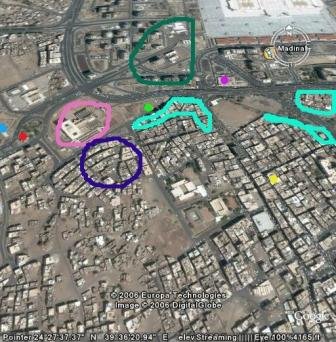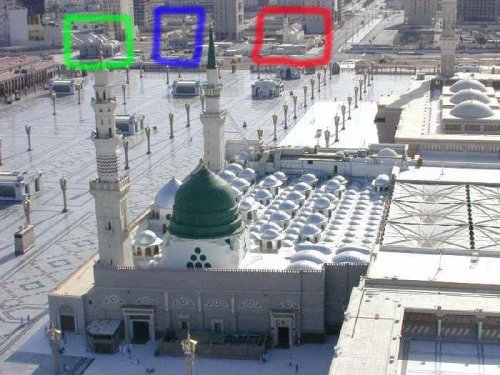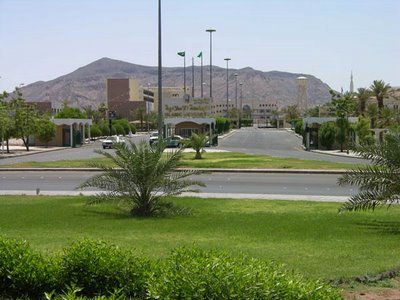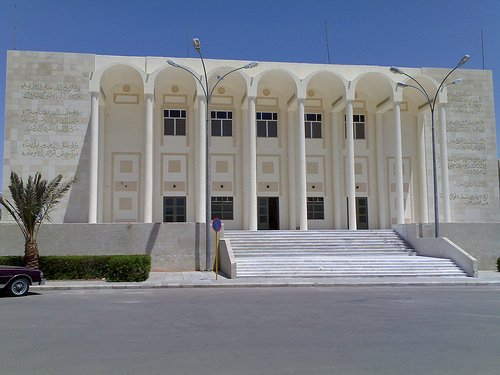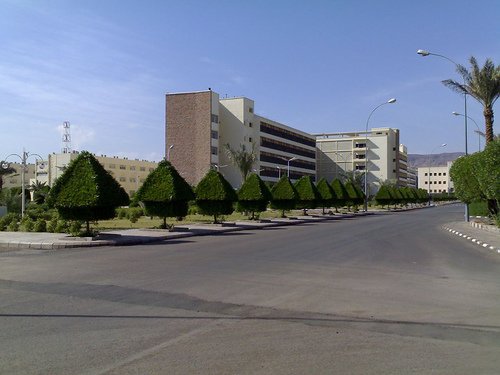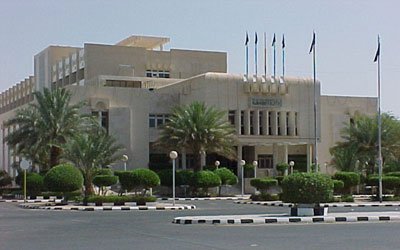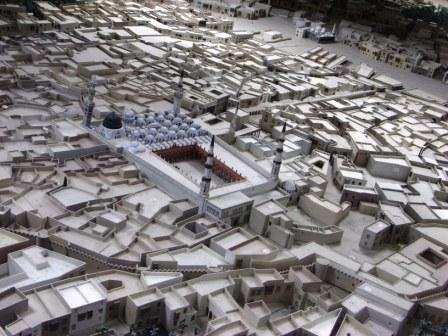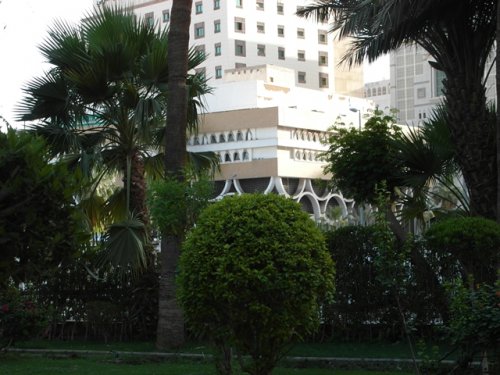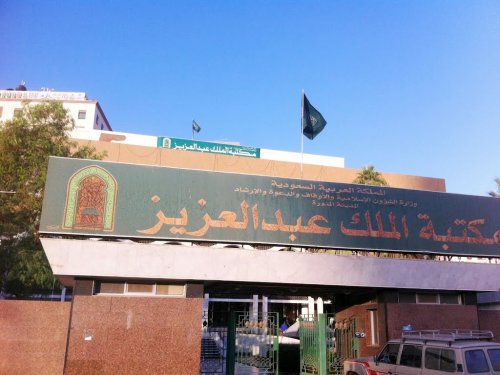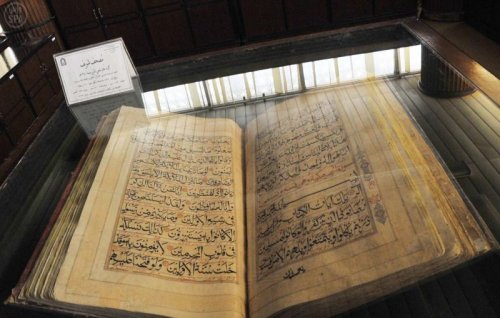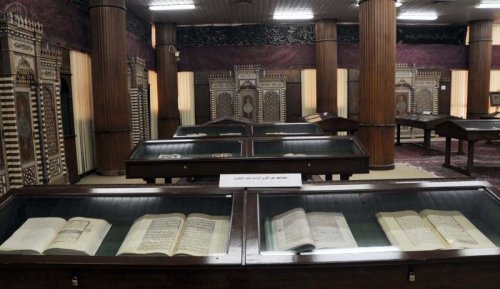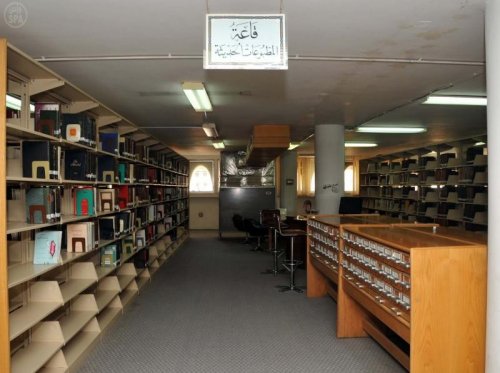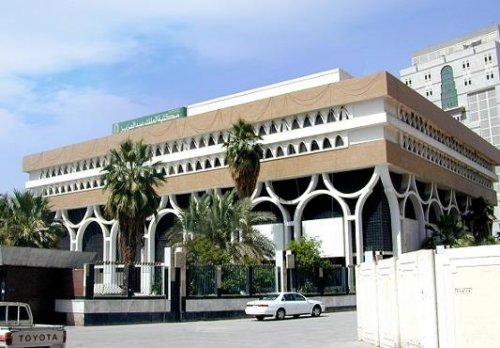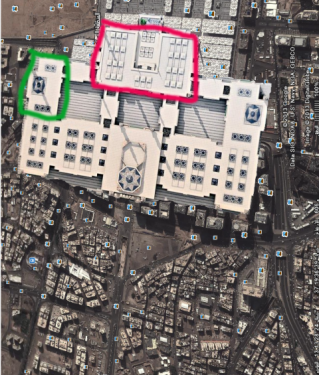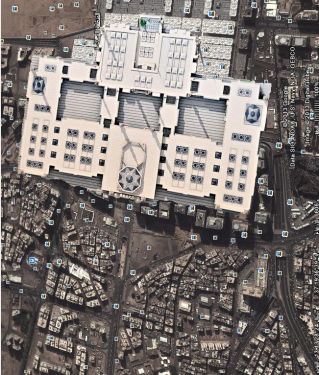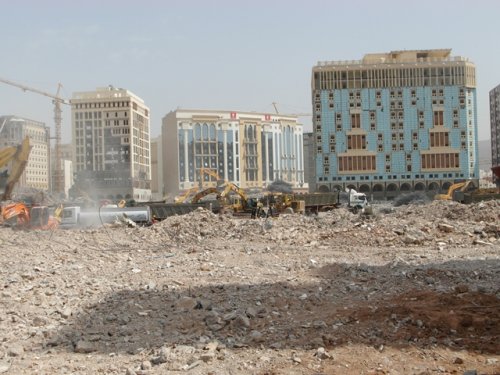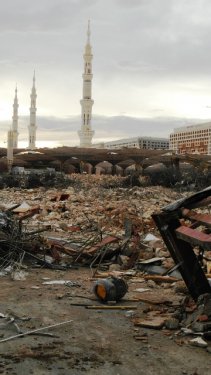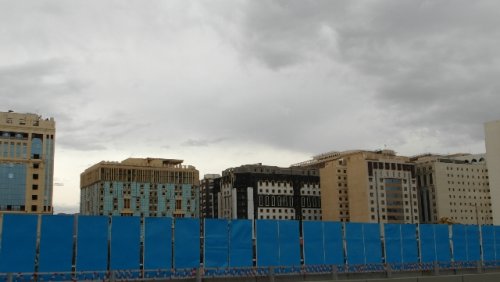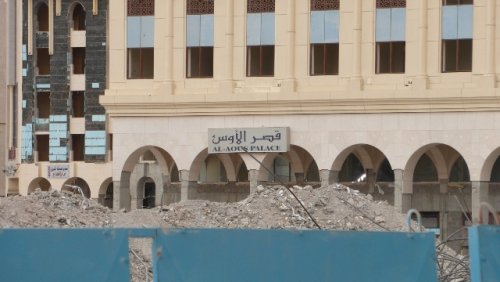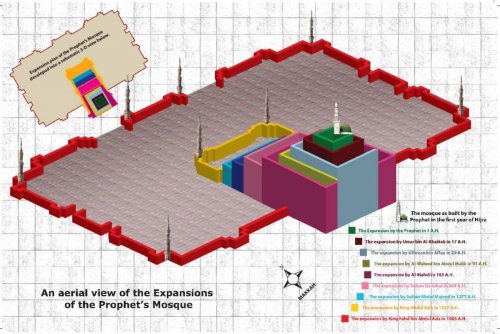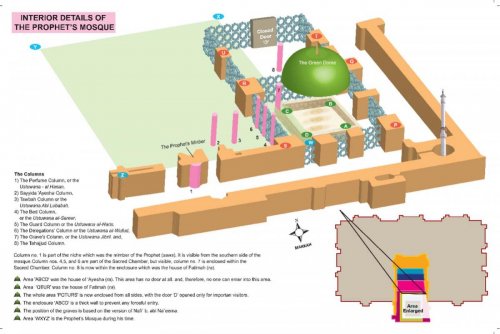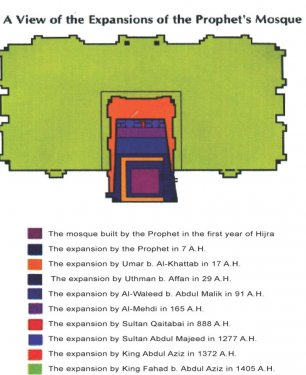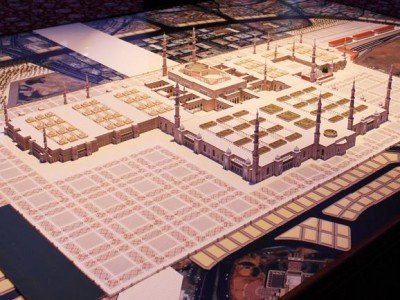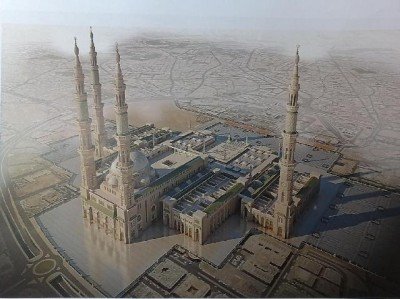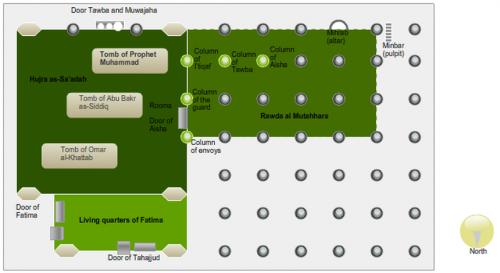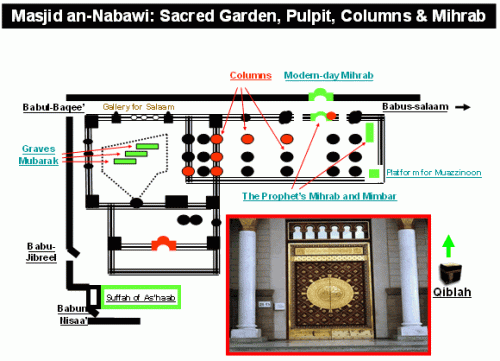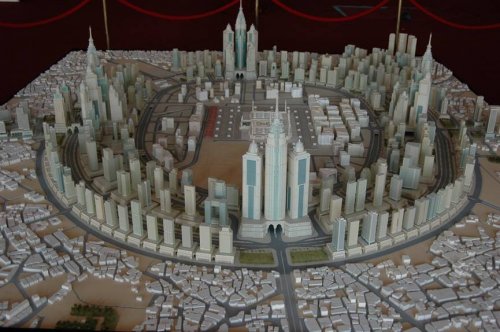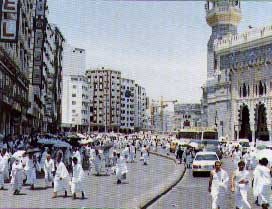-
Posts
8,434 -
Joined
-
Days Won
771
Content Type
Profiles
Forums
Events
Everything posted by ummtaalib
-
A Fleeting EnjoymentBy Imaam Ibn Kathir . "Know that the life of this world is only play and amusement, pomp and mutual boasting among you, and rivalry in respect of wealth and children. (It is) like a rain (Ghayth), thereof the growth is pleasing to the tiller; afterwards it dries up and you see it turning yellow; then it becomes straw. But in the Hereafter (there is) a severe torment, and (there is) forgiveness from Allah and (His) pleasure. And the life of this world is only a deceiving enjoyment." [57:20] Allah the Exalted degrades the significance of this life and belittles it by saying "that the life of this world is only play and amusement, pomp and mutual boasting among you, and rivalry in respect of wealth and children." Meaning, this is the significance of this life to its people, just as He said in another Ayah, "Beautified for men is the love of things they covet; women, children, much of gold and silver (wealth), branded beautiful horses, cattle and well-tilled land. This is the pleasure of the present world's life; but Allah has the excellent return with Him." (3:14) Allah the Exalted also sets a parable for this life, declaring that its joys are fading and its delights are perishable, saying that life is, "Like a rain (Ghayth)," which is the rain that comes down to mankind, after they had felt despair. Allah the Exalted said in another Ayah, "And He is it Who sends down the Ghayth (rain) after they have despaired." (42:28) Allah's statement, "thereof the growth is pleasing to the tiller" meaning that farmers admire the vegetation that grows in the aftermath of rain. And just as farmers admire vegetation, the disbelievers admire this life; they are the most eager to acquire the traits of life, and life is most dear to them, "afterwards it dries up and you see it turning yellow; then it becomes straw." Meaning, that vegetation soon turns yellow in color, after being fresh and green. After that, the green fades away and becomes scattered pieces of dust. This is the parable of this worldly life, it starts young, then matures and then turns old and feeble. This is also the parable of mankind in this life; they are young and strong in the beginning. In this stage of life, they look youthful and handsome. Slowly, they begin growing older, their mannerism changes and their strength weakens. They then grow old and feeble; moving becomes difficult for them, while doing easy things becomes beyond their ability. Allah the Exalted said, "Allah is He Who created you in (a state of) weakness, then gave you strength after weakness, then after strength gave (you) weakness and gray hair. He creates what He wills. And He is the All-Knowing, the All-Powerful." (30:54) This parable indicates the near demise of this life and the imminent end of it, while in contrast, the Hereafter is surely coming. Those who hear this parable should, therefore, be aware of the significance of the Hereafter and feel eagerness in the goodness that it contains, "But in the Hereafter (there is) a severe torment, and (there is) forgiveness from Allah and (His) pleasure. And the life of this world is only a deceiving enjoyment." Meaning, surely, the Hereafter that will certainly come contains two things either severe punishment or forgiveness from Allah and His good pleasure Allah the Exalted said, "And the life of this world is only a deceiving enjoyment." Meaning, this life is only a form of enjoyment that deceives those who incline to it. Surely, those who recline to this life will admire it and feel that it is dear to them, so much so, that they might think that this is the only life, no life or dwelling after it. Yet, in reality, this life is insignificant as compared to the Hereafter. www.islaaminfo.co.za
-
Al-Musalla & Al Munakha Al-Musalla is a ground located South West of Masjid Nabawi. At different places of this ground, Prophet sallallaahu 'alayhi wasallam led the 'Eid prayers, the funeral prayer of Negus and at times the Istisqaa (Prayer for rain during period of drought) prayer too. This ground was also the business place of the Muslims. Trade caravans of camels would stop here thus this place was known as "Manakha". Historical narrations suggest that during the government of 'Umar bin 'Abdul 'Aziz (87AH to 93AH) he built masjids at these places to preserve their history. The Masaajid which were built at this place were Masjid Ghamamah, Masjid Abu Bakr, Masjid Umar, Masjid Ali. From "Pictorial History of Madinah Munawwarah" Dr. Muhammad Ilyas Ghani Walking from the south western corner of Masjid Nabawi, we pass Musalla and Munakha (green circled area) (Map from Al-Miskeenah) In this picture (from skyscrapercity.com) its Masjid Ghamamah, Abu Bakr and Ali Click to enlarge
-
wa'alaykumus salaam http://www.hajjpracticalities.heliohost.org/in_makkah.html i'm posting it again. I just accessed it from the first post
-
yes I can now but yesterday I couldn't though I've visited it often in the last week.
-
Islamic University of Madinah Munawwarah Established in 1381 A.H. It provides courses in five different areas; Faculty of Qur'an, Faculty of Hadith, Faculty of Shariah, Faculty of Da'wah & Usool ud Deen and faculty of Arabic Language. Students with high pass grades are given a chance to enter the M.A. and PhD. degree programs. Entrance Libarary Hostel
-
Madinah Munawwarah Research and Study Centre This centre collects information perstaining to Madinah Munawwarah from various sources and centres. After evrification and research, it is prepared for publication and distribution. It is made available on the internet for people working with projects realated to Madinah Munawwarah. To date, the centre has prepared many programmes on CD and published books. This centre has built models of historic Madinah such as "Old Madinah enclosed in boundary wall" and "Model of old Madinah Munawwarah" (picture below) The following information is from their website. It is a charitable cultural authority concerned with the civilized heritage of Al Madinah in terms of: collecting it from the diverse languages, maintaining it, verifying its manuscripts, and publishing research and studies on Al Madinah Al Munawwarah. Since its beginning till the date of preparing such information, the Center has completed multiple works including: 1- Establishing a library on Al Madina Al Munawwarah combining books specialized in it, sources, and references containing information regarding it. 2- Establishing a database in computer on Al Madina Al Munawwarah. 3- Creating a website relevant to the information of Al Madina Al Munawwarah in the worldwide web in the two Arabic and English languages. 4- Issuing twenty three books on Al Madinah Al Munawwarah. 5- Issuing a judged seasonal magazine to publish the methodological researches on Al Madinah Al Munawwarah in all fields of knowledge. 6- Producing films and programs on Al Madina Al Munawwarah and to be recorded on video tapes and laser discs. 7- Preparing models representing diverse stages of the history of Al Madina Al Munawwarah. 8- Collecting photos of the manuscripts of Al Madinah Al Munawwarah from all over the world and entering them in computer. 9- Preparing an archive for the Ottoman documents on Al Madina Al Munawwarah, exceeding one hundred thousand documents and entering them the computer. 10- Holding scientific symposia and meetings on the history and issues of Al Madinah Al Munawwarah. 11- Holding fairs on the Prophet’s biography and the history of Al Madinah Al Munawwarah.
-
King Abdul Aziz Library in Madinah This library is regarded as one of the largest libraries. Besides many printed books, it stocks a large range of ancient manuscripts as well. It accommodates 1,878 old manuscripts of the Qur'an from which two date back to 488 A.H. and 549 A.H. A hall has been designated for rare books which number over 25,000. An important feature of this library is that a number of old and new libraries of Madinah have been merged into it i.e. the Arif Hikmet Library, Mahmoodiah Library and Madinah Public Library. It is situated to the West of Masjid Nabawi on Manakhah Road. It is open during the day and in the evening and offers photocopying facilities. It conducts a special evening session for female researchers under supervision of female librarians. "Pictorial History of Madinah Munawwarah" Dr. Muhammad Ilyas Ghani" Can be seen from Saqifah Bani Sa'edah (garden mentioned in post number 8 of this topic) Inside
-
Unfortunately even Makkatul Mukarramah & Madeenatul Munawwarah are not free of theft. Watch out for thieves even in the Masjids! A wallet belt is recommended for money and documents worn under the garment. HajjPracticalities advice: Be careful with your wallets/purses/money-belts, as these have been reported to have been snatched away or ripped open, even during Tawaaf/Sa'ee. Unfortunately, there are people who may try to con you with heartbreaking stories, especially in the Holy Places. Be wary of whom you may wish to give Lillah, or indeed, Zakaat. As for beggars, be careful not to pull out all your money as you will be surrounded by more beggars!
-
Wheelchair Service in the Haram Wheelchairs for the Disabled Certain doors in the Sacred Mosque have been assigned for wheelchair-bound pilgrims including King Abdul Aziz Gate, (Door No. 1), Al-Safa Gate, Hunain Gate, Al-Marwah Gate, Othman Gate, Al-Fath Gate, Al-Madinah Gate, Al-Nadwa Bridge, Al-Madinah Bridge, Al-Umrah Gate, Gate No. 64, King Fahd Gate, Gate No. 94, Al-Raguba Bridge, the New Gate of Ajyad. Door No. 11 is the main area for entering the Haram with a wheelchair. Other doors providing wheelchair ramps are Doors No. 10 & 43. Wheelchairs are available from inside the Haram near Safa Gate, Door No. 11. To the right of this door are elevators going to the first floor where you will also find wheelchairs directly in front of you. All these wheelchairs are free but some form of ID has to be deposited as security. There is no one to push these chairs. If you need someone to push then such wheelchairs are available from outside Door No. 13 area and cost about 50 Riyals. However, these are not recommended as the person doing the pushing does not stop at Safa or Marwa for you to perform the Sunnat Du'aa. In addition, he may not have the necessary permit, hence if he sees an official after him, he will tip you out of the wheelchair midway between either your Tawaaf or Sa’ee and you will have lost that money. Note that if you are going to make use of these wheelchairs then you will complete your Sa'ee much earlier than those doing it on foot, hence pre-arrange a meeting place. You need to obtain a permit from the office near Door No. 12 if you have your own wheelchair in order to enter the Haram with your own make and model! If you have your own wheelchair, you will not be allowed entry into the ground floor; you will have to go to the first floor or above. The access to the first floor is via the ramps between Babul Umrah & Babul Fatah and from the Marwa end from Gaza and via a ramp next to the Royal Palace between Bab Malik Abdul Aziz & Safa. There is also a lift access outside Babus Safa. Outside Door No. 1 a new outlet has been opened for free usage of wheelchairs. Ensure that the wheelchairs have a plastic band as a footrest, (as opposed to a metal pedal), since the latter can cause a painful injury to the person in front of you in the crowds. A specific track has now been assigned for the wheelchairs on the first floor of the Haram overlooking the Mataaf. Some of the toilets in the surrounding courtyard have been designed to meet the needs of people with a disability. Hajj Practicalities UPDATE: People using wheelchairs will be using the Temporary Mataaf (See Post number 2 of this topic) which has been in operation since Ramdhaan (2013). From information available online it appears that only one person is allowed to accompany the wheelchair user. Wheelchairs piled high Older style wheelchairs
-
It is quite easy to become lost or separated from ones group during Hajj. On such occasions one can become confused and alarmed. There is no need to feel alarmed since the Hujjaaj are "guests" of Allah ta'ala and He will most certainly create means by which help will become available. Following is information from this Source which will inshaAllah be useful.(there is much more information at the source mentioned however we have posted here only essential information to keep in mind in case of becoming lost or sick) Doors of the Haram There are over a hundred doors to enter the Haram from. All of them look very similar but fortunately, are numbered both on the inside and outside, with most having a name also, the names and numbers being both in Arabic and English. These doors are numbered in an ascending order following an anticlockwise fashion with Bab Malik Abdul Aziz being Gate no. 1. Bab-us-Salaam is Door No. 24 and on many an occasion is closed because of people performing Sa’ee very near this door. Near Door No. 13 is a “Lost and Found Centre”, both for lost articles and lost people on the ground floor and Door 65 on the first floor! Ladies' area is generally to the left hand side of the entrance to the Masjid of most of the main entrances. Be warned that Door No. 1 is usually used for the Janaazaa being carried out after the Fardh Salaat. Thus be co-operative by not blocking this doorway. Disorientation If you do get lost anywhere in the city or its environs, locate the “Pilgrims Assistance Booths” which are set up all over to help the Hujjaajj locate their hotels, tents, Jamaraat, Masjids, etc. Alternatively, all of you could designate a noticeable landmark to meet at in case of getting lost Medical Facilities These are emergency facilities and are situated near Doors No. 5, 64 and 94. There is also an emergency clinic outside Door No. 45 (=Babul Fatha).
-
Current Work Area The green area is where they are currently working… as can be seen it is a fraction of the whole design… the pink is the area of the current Masjid Nabawi Most of these buildings will soon be gone palaces come and go… Insha’Allah our final Blissful Abode will be for ETERNITY… and even the expansion will be dust… More pictures & Info: here & here
-
Diagrams of the Expansion of Masjid Nabawi and Interior Details Diagrams showing the expansions made to Masjid Nabawi since the time of our Prophet Muhammad sallallaahu 'alayhiw asallam. The diagrams showing the interior details gives us a better understanding of the layout. (click on pictures to enlarge) These diagrams shows the interior details Future mega plans!
-
-
Folding of the Kiswah September 2013 In Preparation of Hajj (1434) The black apparel (kiswah) covering the Holy Kaaba was folded three meters up off the ground on Wednesday to prevent pilgrims from touching and damaging it during the Haj season, the Presidency of the Two Holy Mosques Affairs said in a statement. “The area has been covered by a white cloth, which is two meters high and 47 meters wide,” the statement said, adding that this is done just before the peak of the Haj season every year. We have done this as a precautionary measure to prevent people from tampering with the cover, as many people tend to touch the cover during tawaf (circumambulation around the Kaaba),” said Mohammed bin Abdullah Bajouda, director-general of the Kaaba Cover Factory arabnews.com More Pictures Showing Details of the Procedure 24 September 2013 (Pictures by Roukaya19) First the Kiswah itself is rolled up The covering with the white cloth begins Last side
-
QUESTION> What is the Islamic ruling on plucking, shaping and bleaching Eyebrows? <ANSWER> In the name of Allah, Most Compassionate, Most Merciful, Eyebrow shaping has been a very popular issue for some time now, and one which many people seem very confused about. It is a type of personal grooming that involves plucking or trimming the eyebrow hairs for a desired shape. Though both women and men may ‘shape’ their eyebrows, it is a more common practice for women. There are various means of eyebrow shaping such as plucking, trimming and bleaching. In this brief study, we will examine the Islamic perspective on all of these methods, insha Allah. Central to the issue of eyebrow shaping is the famous hadith of the Companion Sayyiduna AbdAllah ibn Mas’ud (may Allah be pleased with him). Let us first look at this hadith, and the various aspects that relate to it. Alqama relates that Sayyiduna AbdAllah [ibn Mas’ud] cursed women who practice tattooing, have [facial] hair plucked and create gaps between their [front] teeth [artificially] to look beautiful; changing the creation of Allah. Umm Ya’qub said [to him], “What is this?” AbdAllah said, “Why should I not curse those whom the Messenger of Allah (Allah bless him and give him peace) cursed and are referred to in the Book of Allah.” She said, “By Allah, I have read [the book of Allah] from cover to cover but have not found such a thing.” So he said, “By Allah, if you had read it [carefully], you would have found it. [Allah says:] “Whatever the Messenger gives you, accept it; and whatever he forbids you from, abstain from it.”(Sahih al-Bukhari 5939 & Sahih Muslim 2125) There are various points of discussion in relation to this hadith: 1) What is the exact meaning of ‘tanmis’ or ‘nimas’ – the root words for the terms ‘namisat’ and ‘mutanammisat’ used in the various versions of this hadith? a) The vast majority of linguistics (ulama al-lugha), jurists (fuqaha) and hadith experts (muhaddithun) are of the opinion that it refers to plucking ‘facial’ hair. As such, the term ‘namisat’ refers to women who pluck their own or others’ facial hair; and in the narration of Muslim, there is an addition of ‘mutanammisat’ which refers to women who have their facial hair plucked by others. Imam Nawawi (Allah have mercy on him) states in his commentary of Sahih Muslim, “Al-Namisa is a woman who removes her facial hair...” (Al-Minhaj sharh Sahih Muslim p: 1602; also see for language references: Al-Nihaya 5/119, Lisan al-Arab 7/101 and Al-Mu’jam al-Wasit 2/955; and for hadith commentaries: Fath al-Bari 10/463 and Umdat al-Qari 15/114; and for fiqh references: Radd al-Muhtar 5:239, Al-Qawanin al-Fiqhiyya, Nihayat al-Muhtaj 2/25 and Kashshaf al-Qina’ 1/81) b) On the other hand, some classical scholars are of the view that ‘nimas’ refers specifically to plucking eyebrows, and some say eyebrows and forehead. Imam Abu Dawud states in his Sunan, “Al-Namisa is a woman who plucks the eyebrows in order to make them thin.” (Sunan Abi Dawud, hadith 3621) Imam Ibn Hajar al-Asqalani states in his commentary of Sahih al-Bukhari, “Al-Nimas is to remove facial hair with a chisel… and it is said that it refers specifically to removing hairs from the eyebrows in order to make them thin or straight.” (Fath al-Bari 10/463) It seems that the difference is one of semantics, since the majority of scholars who say that it refers to the removal of ‘all’ facial hair also make exceptions such as removing hair from the chin, upper lip and forehead (details to follow). As such, the issue remains focused on the eyebrows. This is the reason why some even translate the actual text of the hadith as “those who pluck their eyebrows.” 2) Although the hadith mentions ‘plucking’, most classical scholars hold that it is not restricted to plucking; rather, it includes all ways of reducing the hair. As such, the same ruling will apply to cutting, trimming, shaving, etc. (Nawawi, Al-Minhaj sharh Sahih Muslim p: 1602, Fath al-Bari 10/463, Radd al-Muhtar 6/373, Nihayat al-Muhtaj 2/25 and Kashshaf al-Qina’ 1/81) Imam Ahmad ibn Hanbal (Allah have mercy on him), however, is reported to have allowed reducing eyebrow hairs by means which are other than plucking. However, this remains a minority opinion. (See: Al-Mughni of Ibn Qudamah 1/131) 3) Exceptions from the general prohibition of removing facial hair As mentioned above that even though the hadith in question refers to the removal of all facial hair, the vast majority of classical scholars make certain exceptions. So what are these exceptions? a) Imam Ibn Jarir al-Tabari is of the opinion that the prohibition is absolutely general. As such, according to him, even if a woman develops a beard or moustache, or grows excessive hair on her forehead, it remains impermissible for her to trim or pluck the hair out – regardless of whether she is married and wants to adorn herself for her husband, or otherwise. However, this seems to be an isolated position. (See: Ibn Hajar, Fath al-Bari 10/463) b) According to most classical jurists, however, the general prohibition of removing facial hair is to be restricted due to other texts signifying as such. For example: Imam Abd al-Razzaq relates with his chain of narration that a woman asked the mother of the believers Sayyida A’isha (Allah be pleased with her) whether it was permitted for her to remove facial hair in order to beautify herself for her husband. A’isha (Allah be pleased with her) replied, “Remove what is unsightly from you and adorn yourself for your husband…” (Al-Musannaf no: 5104) Imam Ibn Hajar al-Asqalani relates a slightly different ve rsion of this report. He states in his Fath al-Bari that the wife of Abu Ishaq, who loved to beautify herself, once visited Sayyida A’isha (Allah be pleased with her) and asked, “What if a woman removes the hair from her forehead to please her husband?” She replied, “Remove what is unsightly from you as much as possible.” (Fath al-Bari 10/463) In view of this, the Hanafi and Shafi’i Schools of Islamic law hold that if a woman develops a beard or moustache, it is permitted for her to remove the facial hair growing on her chin, above the upper lip and below the lower lip. In fact, they state that it is recommended since it is to prevent her from resembling men. Imam Ibn Abidin (Allah have mercy on him) of the Hanafi School states, “… If she grows some hair on her face which is a cause of her husband disliking her, then the prohibition of removing such [facial] hair seems far-fetched. This is because [self-] beautification for women is recommended for the sake of chastity… It is stated in Tabyin al-Maharim that removing facial hair is unlawful, unless a beard or moustache grows on a woman, in which case it is not unlawful to remove it; rather, recommended.” (Radd al-Muhtar ala ‘l-Durr al-Mukhtar 5:239) The renowned Hadith expert and Shafi’i jurist Imam Nawawi (Allah have mercy on him), commenting on the hadith, states that a woman who grows a beard, moustache or hair below her lower-lip (anfaqa) is exempted from the generality of this prohibition, and thus it is permitted – in fact, recommended – for her to remove these hairs. (See: Al-Minhaj sharh Sahih Muslim, p: 1602) Shaykh Mufti Rashid Ahmad Ludhyanwi (Allah have mercy on him), the renowned late Hanafi scholar from the Subcontinent, states that it is permitted for a woman to remove facial hair; and if she develops a beard and moustache, it is recommended (mustahab) to remove it. (Ahsan al-Fatawa 8/74) Plucking and Trimming Eyebrows The above concession is concerning the removal of facial hair other than the eyebrows. As for a further concession, in terms of removing eyebrow hairs, there are diverse views and statements of classical jurists (fuqaha) from the four main Sunni Schools of Islamic law and others. Some say that plucking is permitted for a woman who wishes to adorn herself for her husband, whilst others hold that it is unrestrictedly forbidden. Nevertheless, we will first present some of these texts from the classical works of fiqh, and then endeavor to draw up a conclusion, insha Allah. The Hanafi School 1) It is stated in Tahtawi’s commentary on Al-Durr al-Mukhtar, “Al-Nimas is removing facial hair with a chisel (tweezers)… Some commentators of Suyuti’s Al-Jami’ al-Saghir state that ‘nimas’ is specific to the removal of eyebrow hair in order to make them thin and equal. This act is unlawful (haram)… It is permitted [however] to remove hair, dye it red, beautify it and adorn it with the permission of the husband, since it is from [permissible] adornment… The apparent implication of this condition is that the impermissibility is restricted to when it is done without the permission of the husband. It is possible to interpret the [Hanafi] Madhhab on this, because it cannot be denied that nimas – which is a form of hair removal – is from adornment, and a woman is religiously commanded to beautify herself [for her husband].” (Hashiyat al-Tahtawi ala ‘l-Durr al-Mukhtar 4/186) 2) The renowned later authority in the Hanafi School Imam Ibn Abidin (Allah have mercy on him) states concerning the prohibition of plucking facial hair, “It is possible that the prohibition mentioned [in the hadith] is when it is done for the sake of beautifying herself for strangers; otherwise, if she has facial hair which causes her husband to dislike her appearance, then the prohibition of removing such hair seems far-fetched. This is because [self-] beautification for women is recommended in order to look good [for the husband], unless the hadith is interpreted to mean when it is done without a need, since there is harm in ‘plucking’ hair… It is related in Al-Tatarkhaniyya from Al-Mudmarat that there is no objection in removing hairs from the eyebrows and face provided it does not cause one to resemble an effeminate (mukhannas). (Radd al-Muhtar ala ‘l-Durr al-Mukhtar 5:239) 3) It is stated in Al-Fatawa al-Hindiyya, “There is nothing wrong with removing the hair of eyebrows and face as long as one does not resemble an effeminate person [although this seems to refer to males]…” (Al-Fatawa al-Hindiyya 4/23) The Maliki School 1) It is stated in Al-Fawakih al-Dawani, “Al-Tanmis [mentioned as being prohibited in the hadith] is to pluck the eyebrow hairs so that it becomes fine and beautiful. However, the permissibility of removing hair from the eyebrows and face has been narrated from A’isha (Allah be please with her), and it conforms to what was mentioned previously that the relied upon opinion [in the Maliki School] is the permissibility of a woman removing all her hair with the exception of the hair of her head. As such, the [prohibition] in this hadith will be understood to be for a woman who has been prohibited from adorning herself, such as a woman whose husband has passed away [and she is in her waiting period] and a woman whose husband is lost… This cannot be countered by claiming that it results in changing the creation of Allah [meaning the way Allah created you], since not every form of change is prohibited. Do you not consider that the characteristics of natural disposition (khisal al-fitra) such as circumcision, clipping nails and cutting hair; and other similar actions like castrating lawful animals and others besides these are permitted?” (Nafrawi, Al-Fawakih al-Dawani 2/411) 2) It is stated in Hashiyat al-Adawi, “Al-Mutanimmasa is a woman who plucks eyebrow hairs so that it becomes fine and beautiful. The prohibition is for a woman who is forbidden from adorning herself such as a woman whose husband has passed away, and one whose husband is lost. As such, the hadith [of prohibition] does not contradict what is narrated from A’isha (Allah be pleased with her) in regards to the permissibility of removing eyebrow and facial hair.” (Hashiyat al-Adawi ala Kifayat al-Talib al-Rabbani 2/459) The Shafi’i School 1) Imam Shams al-Din al-Ramli (Allah have mercy on him) states, “Al-Tanmis – which is to remove facial hair and eyebrows for adornment – is unlawful. However, if the husband or master [of a slave girl] gives her permission, then it is permitted; because he has an interest in her adorning herself for him, as mentioned in Al-Rawda...” (Nihayat al-Muhtaj ila sharh al-Minhaj 2/25) 2) Imam Khatib al-Shirbini, another Shafi’i jurist, states the same in his Mughni al-Muhtaj explaining that the reason (illa) for the prohibition is deception – such as an unmarried lady deceiving a prospective husband. However, when the illa of deception is absent and a woman’s husband grants her permission, then it is permissible. (Mughni al-Muhtaj 1/294. See also: Tuhfat al-Muhtaj fi sharh al-Minhaj by al-Haytami 2/128, Rawd al-Talib 1/173, Hashiyat al-Jumal, Al-Hawi al-Kabir and other Shafi’i fiqh references) 3) Imam Nawawi from amongst the Shafi’i jurists, however, seems to have a stricter stance. He states in his commentary of Sahih Muslim, “This act [of plucking facial hair] is unlawful (haram), unless a woman grows a beard or moustache, in which case it is not unlawful to remove the hair; in fact it is recommended… The prohibition is of removing eyebrow hairs…” (Al-Minhaj sharh Sahih Muslim, p: 1602) The Hanbali School The more reliable position is that ‘plucking’ (and not other methods of hair removal) facial hair including the eyebrows is unrestrictedly forbidden. However, there are other views within the Hanbali School which state that it is permitted: a) upon the request of one’s husband, b) when there is no deception, and c) when it does not result in imitating immoral and obscene women. Imam al-Mardawi states in his Al-Insaf, “It is unlawful (haram) to pluck [facial hair]… according to the more correct position of the [Hanbali] School. However, it was said [in a weaker opinion] that it is not unlawful… Only Ibn al-Jawzi [from among the Hanbali jurists] permitted plucking, and interpreted the prohibition [in the hadith] as applicable to when there is deception or it becomes the hallmark of obscene women (fajirat). In Al-Gunyah, there is an opinion that it [plucking facial hair] is permitted with the request of the husband.” (Al-Insaf fi Ma’rifat al-Rajih min al-Khilaf 1/125-126; the same is also mentioned by Al-Bahuti in his Kashshaf al-Qina’ 1/76, Ibn Muflih in his Al-Furu’ 1/107-108, and in other Hanbali references) Moreover, the prohibition relates specifically to the act of ‘plucking (nimas).’ As for removing facial hair via other methods such as shaving, trimming and cutting, it seems to be permitted in the Hanbali School. 1) The renowned Hanbali jurist Imam Ibn Qudama states in his Al-Mughni, “Al-Namisa is a woman who ‘plucks’ facial hair, and al-Mutanammisa is one whose facial hair is plucked upon her request. This is not permissible due to the hadith. If [however] she shaves off the hair, there is nothing wrong with that; since the hadith is in reference to plucking. Imam Ahmad (Allah have mercy on him) clearly mentioned this.” (Al-Mughni 1/77, with Al-Sharh al-Kabir) 2) Imam al-Mardawi states, “It is permitted for a woman to shave and trim [her facial hair], as clearly mentioned [by Imam Ahmad].” (Al-Insaf fi Ma’rifat al-Rajih min al-Khilaf 1/126; the same is also mentioned in Kashshaf al-Qina’ and other Hanbali references) Summarizing the Positions of the Four Schools The above quotes from the reliable sources within the four Schools of Sunni Islamic law demonstrate that the jurists (fuqaha) did not take the hadith of AbdAllah ibn Mas’ud (Allah be pleased with him) – in which women who pluck facial hair are cursed – literally; rather, many of them made exceptions or instances of specifications due to other evidences (cited previously), such as the narrations of Sayyida A’isha (Allah be pleased with her) in Musannaf Abd al-Razzaq and Fath al-Bari, and other similar narrations. The first exception is in regards to facial hair besides the eyebrows. Most classical jurists are of the view that it is permitted – in fact recommended – for a woman to remove facial hair growing on her chin, above the upper lip and below the lower lip. Thereafter, many other jurists make further exceptions which relate to the plucking of eyebrows themselves, since the legal maxim reads, “There is no general [prohibition] except that it may be specified.” The Hanafis make an exception for a woman who is married and her husband wants her to adorn herself for him. If she plucks her eyebrows in order to beautify herself for him, then it is permitted; and the prohibition is restricted to when it is done for non-Mahram men, or when the eyebrows are plucked excessively to the point that it distorts her appearance (tashwih). The Malikis seem the most flexible, making an exception for all women to pluck their eyebrows. As such, the prohibition is restricted to a woman who is in a state where she is forbidden from adorning herself such as the post-marriage waiting period (idda). The Shafi’is – like the Hanafis – make an exception for a married lady to pluck her eyebrows with the permission of her husband. As such, the prohibition is restricted to unmarried women who may deceive a prospective husband with plucked eyebrows. The most reliable position in the Hanbali School is that there is no exception, and thus the ‘plucking’ of eyebrows is unrestrictedly unlawful. However, there are other positions within the School that it is permitted for a married lady upon the request of her husband, or when there is no deception, or when there is no imitation of sinful and obscene women. As such, the prohibition is restricted (according to these other positions) to either unmarried women, or when the intention is to deceive a prospective husband or attract the attention of strange men as done by sinful and immoral women. Moreover, the prohibition in the Hanbali School is only for plucking facial hair. As far as the other methods of hair removal are concerned, they are permitted. (See: Al-Mawsu’a al-Fiqhiyya, part 14 on tanammus) The evidence for these exceptions are the previously quoted two reports in which A’isha (Allah be pleased with her) said, “Remove what is unsightly from you [i.e. from facial hair] and adorn yourself for your husband.” Furthermore, it is related from Bakra bint Uqba that she asked A’isha (Allah be pleased with both) about the removal of facial hair, so she replied, “If you have a husband and you are able to remove [excess hair] from [above] your eyes and thus make them appear more beautiful, then do so.” (Recorded by Ibn Sa’d in his Al-Tabaqat al-Kubra 8/70-71 and Imam Dhahabi in his Siyar A’lam al-Nubala 2/188) After surveying the opinions of all four major Schools of Islamic law, we can deduce the following rulings in regards to the plucking and trimming of facial hair and eyebrows: 1) It is permitted for a woman to remove facial hair (besides the eyebrows) – whether she is married or unmarried – especially if she develops a beard, moustache, etc; in which case it is recommended. 2) As for the eyebrows, if there is some sort of defect in them or they seem unsightly because, for example: a) they are unusually thick and bushy, b) they have grown too long and cover the eyes, and thus cause distress, c) they are linked in between, then it is permitted to remove the excess hair, or trim the stray hair, and bring one’s eyebrows back to a more normal size. This is allowed for both married and non married women [and also for men], since the ‘basis’ here is a genuine need. The Shari’ah allows bringing back to normality areas of the body that are deformed, damaged or considered abnormal by ‘sound’ people (and not what the fashion industry dictates) – especially when it results in hardship and psychological pain, and more so, when it may affect one’s aspirations to marry. This is more or less agreed upon by the scholars, and based on several general texts of the Qur’an and Sunna, and statements of classical scholars. In fact, there is a specific hadith in this regard. Imam Ahmad relates in his Musnad from AbdAllah ibn Mas’ud (Allah be pleased with him) who said, “I heard the Messenger of Allah (Allah bless him & give him peace) prohibiting the removal of [facial and eyebrow] hair… except when there is a defect (da’).” (Musnad Ahmad no: 3975) Commentating on this hadith, Imam al-Shawkani states, “The apparent meaning of this [hadith] is that the prohibition applies to when the objective is beatification, and not due to an illness or defect; in which case it is not prohibited.” (Nayl al-Awtar 4/298) 3) If there is no such defect in the eyebrows, then it is not permitted for a non-married woman, or a woman who may expose her eyebrows in front of non-Mahram men, to trim or pluck them even if slightly. 4) If a woman is married and her intention is to adorn herself for her husband; then, upon her husband’s request, it is permitted for her to pluck or trim her eyebrows by making them ‘somewhat’ neater and shaping them ‘slightly’ – provided it is not excessive and exaggerated to the point that it looks unnatural and distorts her appearance (tashwih). As for unmarried women, this will remain impermissible. Islam takes the husband-wife relationship very seriously – emphasizing the importance of both spouses remaining clean, neat and adorned for each other. As such, we see the jurists (fuqaha) from the various schools allowing a married woman to trim her eyebrows in order to beautify herself for her husband, as the narrations from Sayyida A’isha (Allah be pleased with her) indicate. In this case, however, it is necessary that she does not expose them in front of non-Mahram men, since the jurists of the Hanafi and Shafi’i Schools clearly state that such trimmed eyebrows are a means of adornment only for the husband. As such, she must conceal her beautified eyebrows with her Hijab or Niqab when in the presence of non-Mahram men. 5) It is not permitted for both married and non married women to shape the eyebrows excessively such that it distorts the appearance, or in a way that is the hallmark of immoral and corrupt women who are considered sexually promiscuous and whose main aim is to lure men. One must avoid that which becomes the symbol of sinful and immoral activities. As such, it is not permitted to shape one’s eyebrows into a thin fine line as practiced within the modern fashion industry. This is regardless of whether a woman is married or otherwise, and whether she exposes her eyebrows in front of non-Mahram men or not. The concession for married women is merely to ‘slightly’ neaten and shape the eyebrows, and thus great caution must be exercised in this regard. If one fears they will end up trimming the eyebrows excessively, then it is best not to trim at all. Changing the Creation of Allah (taghyir khalq Allah) A question arising here is whether any form of modification to the eyebrows is considered ‘changing the creation of Allah (taghyir khalq Allah)’ – which is emphatically prohibited in Shari’ah. If it does, then it would mean that even married women are not permitted to ‘slightly neaten’ their eyebrows as a form of adornment for their husbands. The answer basically boils down to how we understand the hadith central to our discussion which states, “…women who practice tattooing, pluck [facial hair], and create gaps between their teeth to look beautiful – changing the creation of Allah…” In summary, those who grant concession for married women to pluck or trim their eyebrows argue that not all forms of ‘change’ are unlawful. The text from the Maliki jurist Imam al-Nafrawi was previously cited where he stated, “This cannot be countered by claiming that it results in changing the creation of Allah, since not every form of change is prohibited. Do you not consider that the characteristics of natural disposition (khisal al-fitra) such as circumcision, clipping nails and cutting hair; and other similar actions like castrating lawful animals and others besides this are permitted?” (Al-Fawakih al-Dawani 2/411) Secondly, some scholars argue that the statement “changing the creation of Allah” in the hadith refers specifically to the last of the actions mentioned, namely: “those who create gaps between their teeth to look beautiful.” As such, plucking or trimming eyebrows is not tantamount to “changing the creation of Allah”, and Allah knows best. (See: Ali al-Qari, Mirqat al-Mafatih 8/295) Shaving Eyebrows As for shaving the eyebrows completely and drawing a pencil line in its place, according to the mainstream majority of classical scholars it is not permitted for both married and non married women. This is understood clearly from the many texts quoted above, in that excessive removal of eyebrow hair is impermissible. Although, the Hanbali School allows ‘shaving’ as opposed to ‘plucking’ the eyebrows, it too does not permit its excessive removal, since a woman’s appearance is distorted and results in imitation of immoral and obscene women (fajirat). Bleaching and Dyeing Eyebrows A recent trend has emerged of bleaching the eyebrows in order to make them look thinner and shaped. This is normally done in two ways: 1) Bleaching the top and bottom of the eyebrows with a colour similar to that of the skin. As a result, the eyebrows look as if they have been excessively plucked, thinned and shaped. 2) Bleaching the eyebrows fully with a colour similar to that of the skin, and then drawing a fine pencil line on top of it. As a result, the original eyebrows are not visible due to the bleaching, and instead only a pencil line is noticed. Since bleaching eyebrows in this manner is a recent phenomenon, we do not find it being discussed explicitly by classical jurists. As for the contemporary scholars, they disagree on its permissibility. 1) Some contemporary scholars are of the opinion that it is not permitted to bleach the eyebrows in the manner outlined above, since it resembles and has the same effect as that of excessive plucking. Moreover, the substances used may cause damage to the skin or hair. As such, regardless of whether a woman is married or not, bleaching the eyebrows in this manner is impermissible – according to these scholars. 2) Others, however, say that it is permitted to bleach and lighten the eyebrows in the manner mentioned above, since it is only colouring the hair and not plucking it. The general rule regarding the various means of adornment is that they are permitted unless proven otherwise – according to this group of scholars. It seems, and Allah knows best, that bleaching the eyebrows in the above manner cannot be considered unlawful (haram). The Shari’ah allows colouring and dying one’s hair, with the exception of using pure black dye in order to deceive others. Indeed, the underlying intention in this case is to make the eyebrows appear as though they have been plucked or trimmed, and thus I feel there may be a degree of detestability (karahiyya) in it. As such, it is better and more precautious to avoid doing so, especially when the bleached eyebrows will be exposed in the presence of non-Mahram men. However, it cannot be deemed as haram. Note that the above does not relate to dyeing eyebrows fully with hena or some other substance in order to change grey hair, and not with the intention of making them appear plucked. This, without doubt, is permitted provided one avoids pure black colour and the ingredients used in the hair dye are halal. Summary To sum up, according to the majority of classical jurists, it is permitted for married women to pluck, trim and neaten their eyebrows ‘slightly’ for their husbands, provided they do not expose them in front of non-Mahram men. As for non-married women, this remains impermissible. However, if the eyebrows look deformed and defected then it is permissible for even non-married women to turn them into a more normal size. Trimming the eyebrows excessively into a thin fine line is not permitted for both married and not married women, since it distorts one’s appearance and results in imitating immoral women. And Allah knows best [Mufti] Muhammad ibn Adam Darul Iftaa Leicester , UK http://www.daruliftaa.com/node/7167
-
The Houses of the Companions (Radhiyallaahu 'anhum) Around Masjid Nabawi (Map in Post Number 48) Houses on the West Side 1.Abdullah bin Jaafar (RU) and his house: Near the northwestern corner of the Mosque three houses were in a row and had their doors opened in a street called “Qayasheen Street.” This street ran just south of these houses. There was another street that ran just north of these three homes and it was called “Al Yahya Street”. Abdullah bin Jaafar’s (RU) house was the closest to the northwestern wall of the Mosque among these three houses. Abdullah bin Jaafar (RU) was son of Jaafar Tayyar (RU) the uncle of the Prophet (SAS). When Jaafar Tayyar (RU) migrated to Habsha, Abdullah was born there. Abdullah was headman of his tribe. He was very generous and was a prominent scholar. He was a commander of a troop in Ali’s (RU) army during the Battle of Safain. His contemporaries composed some poetry to praise his skills and personality. He died during 80 Hijrah in Madina Munawwara. His house was originally owned by Abdur Rehman bin Auf (RU). Then Abdullah (RU) owned it. After Abdullah (RU) passed away, it was owned by Muneerah, the freed servant of Umm Musa. Samhoudi (who died in 911 Hijrah) wrote, the house built on this site was used by Sheikh Arif Billah. Later it changed hand and was owned by Qadi Mohi-d-Din. History is silent what happened after that. 2. Talha bin Obaidullah (RU) and his house: He embraced Islam on the preaching of Abu Bakr (RU) at the very dawn of Islam. He was one of those ten companions who were given glad tidings of paradise by the Prophet (SAS). He was also the member of the Shura Council to choose a caliph after Omar (RU). He was extremely generous and hence the Prophet (SAS) used to call him Talha Al Khair or Talha Al Joad or Talha Al Fayyaz i.e. super generous Talha (RU). The Prophet (SAS) made Zubair bin Awwan (RU) his Islamic brother during their stay in Makkah to strengthen their bonds. Similarly, the Prophet (SAS) made Abu Ayub Ansari (RU) his Islamic brother on Talha’s arrival in Madina. He participated in Bait Ridwan. He displayed great bravery during the Battle of Uhad. He stood in front of the Prophet (SAS) during the battle to shield him from arrows coming from the enemy. Abu Talha’s (RU) one hand was totally damaged and his head was also badly hurt during this battle. When enemy troops came very close to the Prophet (SAS), Talha (RU) carried the Prophet (SAS) on his back and climbed on a rock to protect the Prophet (SAS) from the enemies. He took part in the Battle of Jamal on the side of Aisha (RTA). He became a martyr in this battle during 36 Hijrah and was buried in Basrah. His house was adjacent to Abdullah bin Jaafar’s (RU) house as seen in the map. His children divided the house into three parts. Yahya bin Talha took the part adjacent to Abdullah bin Jaafar’s (RU) house. Middle part went to Essa bin Talha and third part went to Ibrahim bin Mohammad bin Talha, the grandson of Talha (RU). These three houses were known as “Houses of Qayasheen” and hence this street was also called “Qayasheen Street.” The main door of these houses also opened into this street. As mentioned earlier, another street run just north of these houses and Yahya bin Talha had an additional door of his house opened into this street. This small door was called the small door of the family of Yahya. Consequently this street came to be known as “ Khokhah Al Yahya.” 3. Zubair bin Awwam (RU) and his house: He belonged to Banu Asad branch of Quraish tribe. He was son of the maternal aunt of the Prophet (SAS). He was also one of ten companions who were given glad tidings of paradise by the Prophet (SAS). He was also a member of the six-men advisory council to choose the third Caliph. At the dawn of Islam he was only a child. He embraced Islam during his childhood. Once he heard that disbelievers have arrested the Prophet (SAS). He immediately came out with an naked sword. This was the first occasion when a Muslim drew a sword for the sake of Islam. The above news, however, turned out to be false. The Prophet (SAS) used to call him Hawari or comrade. The Prophet (SAS) said, “Every Prophet has a comrade or helper. My comrade and helper is Zubair bin Awwam (RU).” The Prophet (SAS) was very happy with him during the Battle of Bani Quraiza. Prophet (SAS) said, “My father and mother are pleased with you, indeed.” Zubair bin Awwam took part in Battle of Badr and all other battles as well. He was with the army of Aisha (RUA) during the battle of Jaml but stayed away from the battlefield. He was traveling toward Basra and reached the Sebaa valley. Ibn Jarmoz approached him from his backside and suddenly attacked him. Zubair bin Awwam (RU) died there and then. There are thirty-seven Ahadith mentioned in Bukhari and Muslim narrated by Zubair bin Awwam (RU). As seen in the map, his house was adjacent to Talha bin Obaid Ullah’s (RU) house. As mentioned in the History of Madina, he divided his house into two parts for his two sons. He gave the eastern part to Omar bin Zubair (RU) and western part to Urwa bin Zubair (RU). Qayasheen Street: This was about three meters wide street that was in front of fourteenth door of the Prophet’s Mosque. It was known by this name till twentieth century of Hijrah. Later it was called the street of the people of Hanbli School of Thought. This street was closed near the house of Zubair bin Awwam’s (RU) house and a door was installed there. This door opened into the Perfume Market. Probably this door was called Khokhah Al Qawarir. 4.Sakina bint Husain (RUA) and her house: She was daughter of Husain (RU). She had very exquisite manners and was full of wisdom. There were many stories to describe her wit. She died during 117 Hijrah. Her house was in front of fifteenth door of the Prophet’s Mosque. At present it should be considered in front of Old Bab Saud. It became part of the Mosque during the second Saudi extension. 5.Tamim Dari (RU) and his house: His full name was Tamim bin Aus bin Khareja. He belonged to Banu Dar tribe. Hence he was called Dari. He was commonly known as Abu Ruqqaya derived from the name of his only daughter. He was a Christian who embraced Islam during 9 Hijrah. There used to be no arrangement for light in the Prophet’s Mosque. He was the first who made the arrangement of light in Prophet’s Mosque. He chose to live in Madina. He however migrated to Syria after Caliph Osman’s (RU) martyrdom. He offered Tahajjud very regularly. One night he recited the following verse during Tahajjud: Al Jathiya # 21 Do those who earn evil deeds think that We shall hold them equal with those who believe and do righteous good deeds, in their present life and after their death? Worst is the judgement that they make. He kept crying whole night while reciting this verse again and again. His house was also near the fifteenth door of the Mosque. There is difference of opinions among the historians regarding the house of Sakina bint Husain (RTA) and Tamim Dari’s (RU) house. Some say that it was the same house. Others hold the opinion that these were two separate houses. This historic house existed till very recently. In 1353 Hijrah Abdul Qaddus Ansari wrote, “At present the upper part of this house is non-existent. The lower part of the house has a stone with the following wording engraved in it.” This is the house of Tamim Dari (RU). (Year of writing 1208 Hijrah). During the first Saudi extension of the Mosque, this broken house was also removed and the land was included into the Mosque. 6.Hassan bin Thabit (RU) and his house: He belonged to the Khazraj tribe of Ansar. He was known as the Prophet’s (SAS) poet. After embracing Islam he devoted his poetic skills for the defence of Islam and the Prophet’s (SAS) Message. He used to stand on a mimber in the Prophet’s Mosque and presented his poetry to the people very eloquently describing the achievements of the Prophet (SAS). The Prophet (SAS) said, “As long as Hassan keeps defending Allah’s Prophet, Allah (SWT) keeps on helping Hassan by Jibreel (AS).” He lived for sixty years as a disbeliever. He lived another sixty years after embracing the Islam. He died during 50 Hijrah. Some families enjoy long lives generation after generation. Hassan’s (RU) father, Thabit, his grandfather, Mundhir, and his great grandfather, Haram, each lived for one hundred and twenty years. His house was like a fort and was known as Fare. In Arabic Fare means an elegant building that lies at a high level. This fort was in front of sixteenth door of the Prophet’s Mosque. The Prophet (SAS) transferred ladies and children of his family to this fort during the battle of Ahzab since there was no other safer place than this. A strange event took place in this fort. A Jew considered it a good opportunity to tease and disgrace the women and children while Muslims men were away in the battlefield. He circled around the fort and peeped into the building wherever he could. The aunt of the Prophet (SAS), Safia (RUA) noticed the activities of this Jew. She hit him with a bamboo stick and killed him then and there. Hassan’s house was purchased by Jaafar bin Yahya, a minister in the cabinet of Haroon Rasheed. He also purchased Atika’s house and joined it with Hassan’s (RU) fort. His new house extended all the way up to Bab Rahmah. In 838 Hijrah, Sultan Shahab-ud-Din Ahmad of India built a school at the site of this fort. Sultan came from Gulburga. This school was known as. During the second Saudi extension it became the part of the Mosque. 7. Atika bint Abdullah (RUA) and her house: She was the mother of caliph Yazeed bin Abdul Malik bin Marwan of Banu Umayya. Her house was near Bab Rahmah. Therefore this Bab was also known as “Bab Atika.” Samhoudi (who died in 911 Hijrah) wrote as follows: “The building on this site is donated for the use of custodial personnel of the Prophet’s Mosque. This building lies on your left hand side as you come out of Bab Rahmah.” 8. Naeem bin Abdullah (RU) and his house: He belonged to Banu Adi branch of Quraish tribe. He was a prominent companion of the Prophet (SAS). He embraced Islam before the migration to Habsha took place. He, however, migrated to Madina much later during the period of Hudaibia Truce. He took part in all the battles after migration. One day the Prophet (SAS) said, “I entered paradise and heard Naeem coughing there.” Since that day Naeem was known as “Nahham” or a “person who coughs.” He became a martyr at a place called “Ajnadeen” during the period of caliph Abu Bakr (RU). Some historian said that he became martyr during 15 Hijrah in the battle of Yarmook. There used to be three-meter wide street that ran from Bab Rahmah into Madina market. If you came out of Bab Rahmah, the first house on the right hand side was Atika’s house and the second one was Naeem’s (RU) house. This house saw many changes but the street was preserved till the first Saudi extension of 1375 Hijrah. 9. Omar bin Khattab (RU) and his house: He belonged to Banu Adi branch of Quraish tribe. He was a person of great dominating personality and was a prominent leader of his tribe before embracing Islam. The Prophet (SAS) wished that Allah guide him to the light of Islam. He accepted Islamic faith five years before Hijrah to Madina took place. Muslims used to pray in hiding till Omar (RU) joined the Muslim ranks and files. Muslims started praying around the House of Allah (Kabah) after Omar (RU) accepted Islam. That’s why the Prophet (SAS) gave him the title of ‘Farooq.’ Caliph Abu Bakr (RU) appointed him his successor. He had somewhat hard temperament but it was due to his straight forwardness and adherence to the truth. He was very courageous and a man of great understanding and farsightedness. He used to express his opinion openly and boldly. Allah (SWT) loved his shrewd opinions and made many of those as Islamic law for all the coming generations. He led a simple life in spite of his high position. It was hard for a stranger to identify Caliph Omar (RU) among a group of Muslims because of his simplicity in his lifestyle. During the period of Caliph Omar (RU) the scholars agreed upon offering twenty rakats Salat Taraweeh in the month of Ramadan. This practice is strictly followed in both Harams and all over the world since that time. Maximum conquests took place during the period of Caliph Omar (RU). A fire worshipper and slave of Mugheera bin Shuba whose name is Abu Lu Lu wounded him during the salat. He died on the first of Muharram 24 Hijrah. Omar (RU) was buried by the side of the Prophet (SAS). As seen in the map, his house was between door seventeen and door eighteen of the Mosque. During Salat-ul-Juma, the rows of worshippers used to extend into Omar’s (RU) house. This house of Omar (RU) is called “Dar-ul-Qada” for the following reason. Omar (RU) made a will to his daughter Hafsa (RUA) and to his son Abdullah (RU). In this will he asked them to sell his house to pay off his outstanding debts. If the proceeds of the house failed to pay off all debts, his tribe Banu Adi should pay rest of the debts. According to his will the house was sold to pay off debts and hence it came to be known as “House for paying debts.” During 138 Hijrah, Ziyad bin Obaidullah was appointed Governor of Makkah and Madina. He removed Dar-ul-Qada and other surrounding houses during 151 Hijrah to serve this land as a courtyard for the Prophet’s Mosque. He installed a new door between Bab Rahmah and door of Abu Bakr’s (RU) house. This new door was called “Bab Ziyad” and a plate with the following wording was placed on the top of this door. To seek the pleasure of Allah (SWT) and for the reward on the day of judgment, the governor has made the extension in the courtyard of the Prophet’s Mosque for the comfort of the visitors to this Mosque (151 Hijrah). This courtyard was between Bab Ziyad and Bab Salam and came to be known as “Rahba-tul-Qada (or Qada courtyard) instead of Dar-ul-Qada. This courtyard was left as it was for a long time. Perhaps Kaafoor Muzaffary, the head custodian of the Mosque was the first to construct a building at this site. Samhoudi (died 911 Hijrah) wrote that the house built on this site near Bab Rahmah was known as Dar Shabak (i.e. house with windows). Adjacent to this house were Jobania School and Hisan Atiq (i.e. old fort). A Joban, head of Mughal forces, built Jobania School during 724 Hijrah. The old fort was probably built by one of governors of Madina. That’s why the governor of Madina used this fort as his residence. During 814 Hijrah, Sultan Giyas-ud-Din, the ruler of Bengal, converted this fort into a school. After the second fire mishap of the Prophet’s Mosque, Sultan Ashraf Qaitabai removed these three buildings during 886 Hijrah. He built a new school and a travel lodge at this site. He also built a minaret at this corner of the Mosque. The justice department used these buildings for a while. By and by they became ruins. Sultan Abdul Majeed Turki built another school, a huge library and a house for the head master during 1237 Hijrah. Sultan Abdul Aziz Turki renovated these buildings during 1282 Hijrah. These buildings and the minaret was removed during the first Saudi extension in 1372 Hijrah. Now they are part of the western open space of the Mosque. Their location is between Bab Rahmah and Bab Salam. 10. Abu Bakr’s (RU) western house: One of the houses of Abu Bakr (RU) was adjacent to the western wall of the Mosque. Its main door was in the west wall of the house. Abu Bakr (RU) also installed a small door in the eastern wall of the house that opened into the Prophet’s Mosque for an easy access to the Mosque. As a mentioned in Bukhari, the Prophet (SAS) said, “Close all those doors which open into the Mosque except the door of the house of Abu Bakr (RU).” When Caliph Omar (RU) extended the Mosque, he included Abu Bakr’s (RU) house into the Mosque. He, however, installed a door in the new western wall of the Mosque in line with the original door of Abu Bakr’s (RU) house. The new door opened into Qada courtyard. As a result of this whenever the Prophet’s Mosque was extended in western direction, this door was moved westward in line with the original door. It was to obey the instruction of the Prophet (SAS) for good. During the first Saudi extension, this door was extended as well. It now consists of three doors and the southern most one is in line with the original door of Abu Bakr’s (RU) house as written on it in Arabic Khokhah Abi Bakr. Small door of Abu Bakr’s (RU) house. The exact location of Abu Bakr’s (RU) western house is as follows. If you walk west ward from Mimbar, the house was located after the fifth pillar from the Mimbar. It was, of course, in line with the door marked “Khokhah Abu Bakr.” It is interesting to note that the above-mentioned order of the Prophet (SAS) was an indicator and prediction that Abu Bakr (RU) would be the first caliph. Note even the door of the house of Abu Bakr (RU) is given permanent identification by Allah (SWT) through the instructions of His Prophet (SAS). 11.Abdullah Bin Mukammal (RU) and his house: Famous historian Ibn Shabba count Abdullah bin Mukkamal among the companions of the Prophet (SAS). Probably he is the one who divorced his wives on his deathbed in order to deprive his wives from the inheritance. However, Caliph Osman (RU) gave the wives of Abdullah their legal share from the inheritance, As seen in the map, his house was opposite to the Naeem’s (RU) house. It’s door opened into the Qada courtyard. Abdullah did not own this house. He had taken it on a deed gift from Abdur Rehman bin Auf (RU). There was Madina market on the west side of this house. This market had fruits, vegetables and shops of goldsmiths. One resident of this house said to the Prophet (SAS), “O dear Prophet we used to have a large family with a lot of wealth at our disposal. Unfortunately the members of our family and our wealth are sharply decreasing since we stepped into this house.” The Prophet (SAS) said to him, “Leave this house and find another residence.” Jobania School was built at the site of this house during 724 Hijrah. This school was there till 886 Hijrah. Sultan Ashraf Qaitabai removed this school building and ordered to build a royal residence and a new school called “Ashrafia School” was built during 886 Hijrah. After the death of Qaitabai, it again came to be known as Jobania School. Hasabulla Makki (who died in 1335 Hijrah) said, “Even now people called it Jobania lodge. The alarming myths of earlier times are still prevalent. We hear some unusual stories from the senior citizens pertaining to the few western rooms of this travel lodge. These stories cannot be easily dispelled.” Allah (SWT) knows the best. 12.Hakim bin Hizam Asadi (RU) and his house: He belonged to Banu Asad branch of Quraish tribe. He was nephew of Khadija (RU) and cousin of Zubair bin Awwam (RU). He was known as Abu Khalid. He was born thirteen years before the event of the owners of the elephants. He took part in battle of Fujjar. This was a long drawn battle during the period of ignorance. Arabs used to respect the three sacred months even before dawn of Islam. However they disregarded the three sacred months during this battle. Hence it was called “Battle of Fujjar” (i.e. the battle of sinners). He was a close friend of the Prophet )SAS) before and after the dawn of Islam. As mentioned in a Hadith, the Prophet (SAS) said at the conquest of Makkah, “If a person took refuge in the house of Hakeem today, he would be granted amnesty.” He accepted Islam on the day of the conquest of Makkah and soon after this took part in the battle of Hunain and Taif. He died during 50 Hijrah or later than that. He also lived for one hundred and twenty years like Hassan bin Thabit (RU). Sixty of these years were before the dawn of Islam and sixty years after the dawn of Islam. His house can be seen in the map. The door of this house opened into a street lying just west of the house. Samhoudi said that there used to be a fruit market in this street during the end of ninth century and the early part of the tenth century Hijrah. 13.Mutee bin Aswad (RU) and his house: He belonged to Banu Adi branch of Quraish tribe. He accepted Islam at the time of the conquest of Makkah. He was one of those who were helped financially to reinforce their faith called “Muallifa-tul-Qaloob”. His faith was firmed up later on. His original name was Asi i.e. disobedient. The Prophet (SAS) changed his name to Mutee i.e. obedient. This is how it happened. One day the Prophet (SAS) was delivering a sermon to his companions from the mimbar. The Prophet (SAS) said to his companions, “Sit down.” Asi was on his way to the Mosque when he heard this instruction of the Prophet (SAS). Asi sat down where he was on hearing this instruction. Later on the Prophet (SAS) said to Asi, “How come I didn’t see you in this sermon?” Asi said, “O dear Prophet, I was on my way to the Mosque when I heard you saying ‘sit down’. I sat down there and then to follow your instructions.” The Prophet (SAS) said to him, “You are not Asi (i.e. disobedient). You are Mutee (i.e. obedient).” Since that time he came to be known as Mutee. He died during the period of caliph Omar (RU). His son Abdullah bin Mutee was the commander of the residents of Madina during 63 Hijrah. Mutee’s house was known as Anqa. Please see the map for its location. During fourteenth century Hijrah, Fakhri Pasha removed this house and also other houses around it to extend the courtyard of the Mosque. 14.Abdullah bin Saad (RU) and his house: He belonged to Banu Amer branch of Quraish tribe. He was an outstanding horse rider. He was very capable and a man of great understanding. He was one of the prominent leaders of Quraish tribe. He embraced Islam before the conquest of Makkah and he migrated to Madina. He used to write and record the revelations brought to Prophet Mohammad (SAS) by Jibreel (AS). A big accident took place in his life. The accident was that he reverted back to disbelief after embracing Islam on account of some doubts created in his mind. However, Allah (SWT) wanted him to play a bigger role in near future. By grace of Allah (SWT), he again embraced Islam on the very day of the conquest of Makkah. Now his faith was even firmer. So much so that he was appointed governor of Egypt during 25 Hijrah. Not only that, whole Africa was conquered by him during 27 Hijrah. He used to make the following supplication: “May Allah (SWT) make my last action in this life as salat.” Allah (SWT) granted his supplication. He died during 30 Hijrah when he was offering salat. A street used to run westward from Bab Salam. If you come out of Bab Salam, the first house on the right hand was owned by Abdullah bin Saad (RU). He bought this house from Abbas (RU) for thirty thousand dirhams. After Abdullah’s death it was inherited by his son, Owais and came to be known as Awais house. During the middle of ninth century Hijrah, Qadi Abdullah Basit built a school on this site that was called “Basitia School.” 15.Muawiya (RU) and his house: He belonged to Banu Ummaya branch of Quraish tribe. He was very capable and a man of great understanding. He was serene and gentle in personality. He was very eloquent in his speech. He also used to write and record the revelations brought to Prophet Mohammad (SAS) by Jibreel (AS). As mentioned in Tirmidhi, the Prophet (SAS) made the following dua for Maawiya (RU). Oh Allah, please enable Muawiya to provide guidance to others. Please keep him on your guidance and make him provider of the guidance to the Ummah. He was appointed governor of Syria. He became caliph after Hasan (RU) withdrew himself. He was caliph for twenty years. He died on the 22nd of Rajab 60 Hijrah when he was seventy-eight years old. The door of his house also used to open into the adjacent street lying just east of his house. 16. Nufil bin Haris (RU) and his house: He was uncle of the Prophet (SAS). He was one of the prisoners in the Battle of Badr. Later on he embraced Islam and migrated to Madina. Prophet (SAS) made Islamic brotherhood between him and Abbas (RU). Both loved each other deeply even before the dawn of Islam. So much so that their all assets were common. Nufil (RU) took part in conquest of Makkah and battles of Hunain and Taif. Nufil (RU) was one of those who displayed steadfastness during the Battle of Hunain. He used three thousand arrows against the enemy and stood by the Prophet (SAS) during the critical hours. The Prophet (SAS) granted side-by-side pieces of land to Nufil (RU) and Abbas (RU). Both built their houses on them. During the extension of Mosque by caliph Omar (RU), Abbas’ (RU) house was definitely included in the Mosque. Probably Nufil’s (RU) house was not included at that time. Just south of Nufil’s (RU) house was palace of Marwan bin Hakam that was used as residence by governor of Madina. 17.Ammar bin Yasir (RU) and his house: His mother was a freed slave of Banu Makhzum. Ammar and his parents embraced Islam at the very dawn of Islam. They experienced extreme torture from the disbelievers due to their new faith. Whenever the Prophet (SAS) saw them being tortured by the disbelievers, he said, “O family of Yasir, be patient, your abode is Paradise.” The whole family of Yasir (RU) is included in the group of believers who were foremost in embracing Islam and would be, by the grace of Allah (SWT), the foremost to enter the paradise. Prophet (SAS) gave him two very enviable titles Tayyeb i.e. good person and Mutayyeb i.e. who makes others good persons. One of his ears was chopped off during the battle of Yamama. When caliph Omar (RU) appointed him governor of Kufa, Omar (RU) wrote the following letter to the people of Kufa, “O residents of Kufa, I am sending to you a very prominent and highly respected companion of the Prophet (SAS).” He was martyred during the battle of Safain when he took part on the side of Ali (RU). He was ninety-three years old. The scholars agree that the following verse was revealed about him. An-Nahl # 106 Whoever disbelieved in Allah after his belief, except him who is forced thereto and whose heart is at rest with Faith; but such as open their breasts to disbelief, on them is wrath from Allah, and theirs will be a great torment. His house was on the southwestern corner of the Mosque. Abbas’ (RU) house was just east of it and Abu Sabra’s (RU) house was just north of it. Nowadays if you enter the Mosque from Bab Salam, the location of the houses of Ammar (RU) and Abu Sabra (RU) are near the second column on your right hand side. 18.Abu Sabra bin Abi Rahm (RU) and his house: He was son of the Prophet’s paternal aunt. His mother was Barra bint Abdul Muttalib. He first migrated to Habsha. Later he migrated to Madina. He moved to Makkah after the Prophet (SAS) left us. He died during the period of caliph Osman (RU). The location of his house is described above along with Ammar’s (RU) house. This house was included in the Mosque during the extension of the Mosque by Omar bin Abdul Aziz (RU). 19.Rabah Aswad (RU) and his house: He was freed slave of the Prophet (SAS). He used to get permission (from the Prophet (SAS)) for any companion who wished to see the Prophet (SAS). One time the Prophet (SAS) separated himself temporarily from all his wives for a period of one month. The Prophet (SAS) was residing in a building occupied by Maria Qibtiya (RUA) in an area of Madina called Awali. It was Rabah (RU) who got permission for Omar (RU) to see the Prophet (SAS) during this sensitive situation. Rabah (RU) had black color and it became part of his name and he came to be known as Rabah Aswad (Aswad means black in Arabic). As mentioned in History of Madina, his house was near Bab Salam and in the western corner of Abu Sufyan’s (RU) house. 20. Abu Sufyan (RU) and his house: He was father of Muawiya (RU). His name was Sakhr bin Harb bin Omayya but was known as Abu Sufyan. He was very intelligent and had very dominating and commanding personality. He always came up with his novel opinions and their justification in various matters. He embraced Islam on the day of conquest of Makkah. The Prophet (SAS) raised Abu Sufyan’s morale by making the following announcement on the day of conquest of Makkah, “Whoever took refuge in the house of Abu Sufyan (RU) will not be harmed in anyway.” It should be noted that, at the dawn of Islam, whenever disbelievers tortured the Prophet (SAS) he used to take refuge in the house of Abu Sufyan (RU). By making above announcement at the conquest of Makkah the Prophet (SAS) returned the favor of Abu Sufyan (RU) to him. There used to be a statue of Manat at a place called Qudaid. The Prophet (SAS) appointed Abu Sufyan (RU) to destroy it completely. Abu Sufyan (RU) died during 31 Hijrah or a bit later than that. He was eighty-eight years old. He lost his eyesight during the last part of his life. His house was west of the house of Marwan. Abu Sufyan’s (RU) house was the highest and the most magnificent among all the houses in Madina. Miqdad’s (RU) house was on one corner of it. Yazeed bin Abdul Malik purchased the house from the family of Abu Sufyan (RU). He also purchased the houses of Rabah (RU) and Miqdad (RU). He built a very lofty palace at this site. 21. Miqdad bin Amr (RU) and his house: Miqdad bin Amr bin Thaalba (RU) came to Makkah and, by an agreement, became ally of Aswad bin Yaghus. Aswad highly honored Miqdad. So much so that he made him his son. Consequently Miqdad came to be known as Miqdad bin Aswad instead of Miqdad bin Amr. Allah (SWT) did not approve this custom of that time. Quran announced in Al-Ahzab # 5 Call them by their fathers: that is more just with Allah. After this revelation he was called Miqdad bin Amr (RU) again. Miqdad bin Amr (RU) was one of the seven companions who were the foremost in embracing Islam at the dawn of Islam. He migrated to the Habsha due to the tortures of the disbelievers. He later migrated to Madina. He married the daughter of the Prophet’s uncle, Zubair bin Abdul Muttalib. Her name was Zabaah. Abdullah bin Masood (RU) said, “I heard one special statement from Miqdad (RU). I wish I had the honor to make this statement in his place. I would have love this action on my part more than the entire world put at my disposal.” He added, Miqdad (RU) said to the Prophet (SAS) at the time of Battle of Badr, ‘O! Prophet of Allah, I swear that we will not say to you what people of Musa (AS) said to him. Al-Maidah # 24 So go you and your Lord and fight you two, we are sitting right here. Miqdad (RU) added, “We will rather fight on your right and left and in front and behind of you.” Abdullah bin Masood (RU) noticed that the Prophet’s (SAS) face blushed with happiness to see the courage and firm faith of Miqdad (RU). Miqdad bin Amr had very high place in the eyes of the Prophet (SAS). Miqdad (RU) died at the place called Jurf which lies about three miles from Madina. He was seventy years old. His body was brought to Madina and Caliph Osman (RU) led his Salat-ul-Janaza. He was buried in Baqee. END of "The Houses of the Companions (Radhiyallaahu 'anhum) Around Masjid Nabawi " posts
-
The Houses of the Companions (Radhiyallaahu 'anhum) Around Masjid Nabawi (Map in Post Number 48) Houses on the North Side 1. Abdur Rehman bin Auf (RU) and his house: He belonged to Banu Zuhra branch of Quraish tribe. He was born ten years after the event of the owners of elephants. His name, during the period of ignorance, was Abdul Kabah. The Prophet (SAS) changed it to Abdur Rehman. He embraced Islam through the preaching of Abu Bakr (RU). He first migrated to Habsha and later to Madina. He took part in all the battles with the Prophet (SAS). He is one of those ten companions who were given glad tiding of Paradise by the Prophet (SAS). He was nominated by Caliph Omar for the advisory council of six persons to choose the next caliph. He was very rich and loved to give away his wealth in charity. He died during 32 Hijrah. He left behind thousands of cattle and a very rich inheritance. For example, after distributing of gold to all his legal heir, each of his four wives received eighty thousand dinars. 1(a) It appears from various narrations that Abdur Rehman bin Auf (RU) had several houses around the Prophet’s Mosque. One of his houses was opposite to the ninth door of the Mosque and it was known as or a guest house since he use to accommodate the guests of the Prophet (SAS) in this house. It was also called a big house since it was the largest house among the emigrants. According to Samhoudi (who died in 911 Hijrah), there was a building on this site known as guest house. As mentioned in Vafa-ul-Vafa, there was a huge garden of Abu Talha (RU) just north of the Prophet’s Mosque. The Prophet (SAS) granted some pieces of land of this garden to many of his companions. Abdur Rehman bin Auf (RU) received a piece of this garden and he built this famous guesthouse on it. 1(b) Abdur Rehman bin Auf (RU) had three other houses just north of the Mosque. These houses were joined with each other and hence they were called Karain. When Omar bin AbdulAziz (RTA) was governor of Madina, he removed these three houses in order to extend the Prophet’s Mosque. 2. Mulaika bint Khareja (RUA) and her house: She was daughter of Khareja bin Sanan and wife of Zabban bin Sayyar. On the death of her husband, her son, Manzoor bin Zabban married her in accordance with the social practice of the time of ignorance. Islam totally stopped these dirty practices and released Mulaika and other three women from such similar relationship. In this way Islam safeguarded the chastity and honor of these women. Mulaika came to Madina during the period of caliph Abu Bakr (RU). He asked the companion of the Prophet (SAS), “Who would like to provide shelter to this widow?” Abdur Rehman bin Auf (RU) was very rich and he owned many houses. He rose and took Mulaika to one of his houses for her exclusive use. This house came to be known as Mulaika’s house. So much so that the door of the Mosque opposite to this house was also called Bab Mulaika. When caliph Mehdi extended the Prophet’s Mosque, part of this house was included in this extension. 3. Abu Talha Ansari (RU) and his garden: His name was Zaid bin Sahl bin Aswad but he was known as Abu Talha (RU). He belonged to Banu Najjar branch of Khazraj tribe. He was famous for his bravery and marksmanship. Abu Talha (RU) was one of those twelve persons who promised to safeguard the life of the Prophet (SAS). This commitment was made during Uqba pledge and Abu Talha (RU) fulfilled this commitment in a unique way during the Battle of Uhad. He was shooting arrows at the enemy while keeping his body in front of the Prophet (SAS) to safeguard the Prophet (SAS) during the Battle of Uhad. Whenever the Prophet (SAS) leaned to one side to see where the arrow of Abu Talha (RU) fell, Abu Talha (RU) also leaned towards that direction to shield the Prophet (SAS) with his body. He wished that the Prophet (SAS) was not hurt in anyway. The Prophet (SAS) said, “Abu Talha’s voice is equivalent to the voice of a troop,” Abu Talha (RU) had the privilege and honor to sit behind the Prophet (SAS) on his camel during the battle of Khaiber. Abu Talha (RU) died during 34 Hijrah when he was seventy years old. Caliph Osman (RU) led his Salat-ul-Janaza. He was buried in Madina. Abu Talha (RU) owned a very huge garden that was situated just north of the Prophet’s Mosque. There was a well in this garden. The Prophet (SAS) drank water from this well. This well existed till second Saudi extension of the Mosque. The site of this well lies inside the Mosque at present. If you enter the Mosque from Bab Fahd, you will see a few circles marked on the floor to mark the location of this well. It is, however, not correct to touch or kiss this place as some ignorant people try to do. It is mentioned in Bukhari and is narrated by Anas (RU) about the remarkable submission of Abu Talha (RU) to Allah (SWT). Anas (RU) said, “Abu Talha (RU) owned maximum number of palm trees in Madina. One of his gardens was Bir Ha and it was adjacent to the Prophet’s Mosque. He loved this garden the most. The Prophet (SAS) used to visit this garden and loved to drink sweet water of well there. When the following verse was revealed (Al-Imran # 92 ). By no means shall you attain Al-Birr, unless you spend of that which you love; and whatever of good you spend, Allah knows it well. You can achieve the utmost piety until you spend in the path Allah (SWT) what you love the most. Abu Talha (RU) rose and said to the Prophet (SAS), “O Prophet of Allah, I love my garden Bir Ha the most. I donate it in the path of Allah (SWT) hoping to be rewarded for it on the Day of Judgment. Please make use of it in the way you consider it appropriate. The Prophet (SAS) was filled with joy and he said, Fantastic, it is a wonderful commodity, it is a wonderful commodity. The Prophet (SAS) added, “I heard what you said. It will be better if you distribute it among your relatives.” Abu Talha (RU) distributed it among his relatives as instructed by the Prophet (SAS). 4. (a) Makhrama bin Nofal (RU) and his house: He belonged to Banu Zahra branch of Quraish tribe. He accepted Islam on the day of conquest of Makkah. Gradually he became very firm in his faith. He took part in the battle of Hunain with the Prophet (SAS). He was a very outstanding scholar of the history of Arabs and especially of Quraish tribe. He died in 54 Hijrah when he was 115 years old. He lost his eyesight during the last part of his life. His house can be seen in the map. (b) Miswar bin Makhrama (RU): He was son of Mukhrama bin Nufil and lived in the above house with his father. His mother was Atika bint Auf (RUA), the sister of Abdur Rehman Bin Auf (RU). He was born during 2 Hijrah. He was a prominent scholar of Islamic jurisprudence. After the martyrdom of caliph Osman (RU), he moved to Makkah. He took a pledge with Abdullah bin Zubair (RU). A stone struck him while he was offering his Salat. In this way he became a martyr in Hateem of Kabah during 64 Hijrah. He was 62 years old. Abdullah bin Zubair (RU) led his Salat-ul-Janaza. Caliph Mehdi purchased part of his house to include it in the Mosque. He also built a minaret of the Prophet’s Mosque at this site on the northeastern corner of the Mosque. Rest of this house was purchased by the family of Mutrif. Later on Jafar bin Yahya (RU) bought it from Mutrif family. It became part of the development that was known as the houses of the donated land. 5. Abdullah bin Masood (RU) and his house: He belonged to Hazeel tribe. He was a very prominent companion of the Prophet (SAS). He was outstanding scholar and had memorized Quran by heart. The Prophet (SAS) loved to listen his recitation of Quran and he encouraged his companions to recite Quran like Abdullah bin Masood (RU). He served the Prophet (SAS) in the every possible way he could. For example to wake the Prophet (SAS) for Tuhajjad, help him put on his shoes, hold a sheet to provide privacy during the Prophet’s (SAS) bath, fetch his toothbrush and to act as a guide on a street were some of the duties he used to perform. He was allowed to visit the Prophet (SAS) even during his private hours. When the following verse was revealed (Al-Maidah # 93) Those who believe and do righteous good deeds, there is no sin on them for what they ate, if they fear Allah, and believe and do righteous good deeds, and again fear Allah and believe, and once again fear Allah and do good deeds with perfection. And Allah loves the good-doers. The Prophet (SAS) said to Abdullah bin Masood (RU), “You are also from these people.” Abdullah bin Masood (RU) was a short stature. Hence Omar (RU) used to say, A small vessel or container but totally filled up with knowledge. There are 64 Ahadith narrated by him mentioned in Bukhari and Muslim. He died in Madina during 33 Hijrah when he was more than 60 years old. He was buried in Baqee. When Abdullah bin Masood (RU) and his brother Atba bin Masood (RU) migrated to Madina, the Prophet (SAS) granted them land on the north side of the Prophet’s Mosque. Both of them built humble houses on that land. Since Abdullah bin Masood (RU) used to teach Quran, his house came to be known as Dar-ul-Qurra. When Omar bin Abdul Aziz (RTA) extended the Mosque during 91 Hijrah, he annexed the southern part of these two houses with the Mosque. When caliph Mehdi bin Mansur Abbasi extended the Mosque, he included the remaining parts of these houses in the Mosque. 6. Atba bin Masood (RU) and his house: He was brother of Abdullah bin Masood (RU). He first migrated to Habsha. He came to Madina after the Battle of Badr and hence could not take part in it. He, however, took part in all the other battles. Ibn Shehab Zuhri said, “We did not consider Abdullah bin Masood (RU) bigger scholar than his brother Atba (RU). Atba (RU) however died very soon during the period of caliph Omar (RU).” Abdullah bin Atba (RU) said, “When my father died, my uncle Abdullah bin Masood (RU) could not help crying. Someone asked him, ‘Why are you crying?’ My uncle said, ‘Atba was my brother. We were together in the company of the Prophet (SAS). I loved him the most among all the people.’” As mentioned above, his house was beside of Dar-ul-Qurra and Omar bin Abdul Aziz (RTA) included it in the Mosque during the extension. 7. Umm Habiba (RUA) and her house: She had a house given to her by the Prophet (SAS) that is described in chapter three. She also had a house on the north side of the Mosque that she got through inheritance. This house was not touched during the extensions of Omar (RU) and Omar bin AbdulAziz (RU) since it was situated relatively far away from the Mosque. During Mehdi’s extension part of this house was included in the Mosque. The remaining part of this house was purchased by Yahya bin Khaled. It is said that this is used to be part of Abu Talha’s (RU) Bir Ha.
-
The Houses of the Companions (Radhiyallaahu 'anhum) Around Masjid Nabawi (Map in Post Number 48) Houses on the East Side 1. Osman bin Affan (RU) and his houses. He belonged to Banu Omayya branch of Quraish tribe. His ancestral link joins with the Prophet (SAS) after five steps. He accepted Islam with the preaching of Abu Bakr (RU) at the dawn of Islam. He used to say, “I am the fourth among the four persons who accepted Islam in the very beginning.” The Prophet (SAS) gave him the good tiding of Paradise. He first migrated to Habsha and later to Madina. He had the unique honor of marrying two daughters of the Prophet (SAS) one after the other. He was, therefore, called Dhul Nurain i.e. owner of two lights. He first married Ruqayya (RUA), and could not join battle of Badr due to her severe illness. He, however, received the reward and his share in the bounty. He married Umm Kalsum (RUA) after Ruqayya’s death. He became Caliph in Muharram 24H and became martyr in 35 H. He was buried in Baqee. The Prophet (SAS) granted him a piece of land on the east side of the Mosque. Osman (RU) built a house on it. This house is called Darul-Kubra or the large house. Osman (RU) bought some land on the east side of this house and built a house on it too. This second house is called Darul Sughra or the small house. (A) Large House: According to the historians, the large house was situated between Bab Jibreel and Habsha Street. Habsha Street ran between the houses of Abu Ayyub Ansari (RU) and Osman (RU). This street was 2½ meters wide. The street lost its identity during the first Saudi extension. Whenever the Prophet (SAS) visited Osman’s (RU) house he often used Bab Jibreel for it. Hence Bab Jibreel is sometimes called Bab-un-Nabi or Bab Aal Osman. As mentioned above, on the south of this large house was Habsha Street. North of this large house was Baqee street. East of it was smaller house of Osman (RU). While west of the large house was the site for Salat-ul-Janaza. Later on this house was divided into three parts. A facility for accommodating the poor and needy was built in the portion facing Bab Jibreel by Jamal-ud-Din Mohammad bin Abu Mansur Asfahani. This facility was known as Rubat Asfahani or Rubat Ajam. This facility existed till the first Saudi extension. Asad-ud-Din Shairkoh was the uncle of Salah-ud-Din Ayubi. He bought the southern side of this Rubat in 576H. He and the father of Salah-ud-Din (namely Najm-ud-Din Ayubi) were buried in this piece of land. The remaining part of this large house was south of the Rubat. That portion was exclusively used for the service personnel of Haram. Later on the scholars of Haram used it for their residence. This part, therefore, was known as Dar Mashaikh Haram. As mentioned by Mohammad Labeeb Batnuni, Osman (RU) became a martyr in this very southern most part of the large house. Labeeb visited Madina in 1326 A.D. and he found the following writings on top of window of a room in this southern portion. This is the site where Osman (RU) became a martyr. 1(B) Small House: This house was adjacent to the large house and was just east of the large house. As seen in the map, Abu Bakr’s (RU) house was north of this small house and a street, known as Baqee Street, ran between them. The murderers of Osman (RU) first got into this small house and made their way to the large house to commit heinous crime. Later on a travel lodge was built on the small house, which existed till first Saudi extension. At present it is part of the eastern open space of the Mosque 2.Ali (RU), Fatima (RUA) and their house: Ali (RU) was the cousin of the Prophet (SAS). He was also the son in law of the Prophet (SAS). The Prophet (SAS) brought him up. He accepted Islam when he was only ten years old. He took part in all the battles except battle of Tabuk. The Prophet (SAS) gave him the glad tiding of Paradise. He was the fourth Caliph. He became a martyr on the 17th of Ramadhan by Abdur Rehman bin Muljim Kharji. Ali’s (RU) son, Hasan (RU), led the Salat-ul-Janaza. Kufa was the capital at that time. Hence he was buried there in the Caliph’s residence. The grave of Ali (RU) was unmarked for the fear of disgracing the body by Kharjees. Fatima (RUA) and her house: Fatima (RUA) was the youngest daughter of the Prophet (SAS). She was also known as Zahra. She was married to Ali (RU) during 2 Hijrah right after the Battle of Badr. She had three sons Hasan, Hussain and Mohsin. She had also two daughters Umm Kalsum and Zainab. She died six months after the Prophet’s (SAS) demise. Caliph Omar (RU) married Fatima’s daughter, Umm Kalsum. As mentioned in Musnad Ahmad and narrated by Abdullah bin Abbas (RU), the Prophet (SAS) said, “The headwomen for the people of Paradise will be Maryam, then Fatima, then Khadija and then Asia.” The house of Ali (RU) and Fatima (RUA) was surrounded by the followings. 1. On its south was Aisha’s (RU) house. 2. On its north side was the footpath coming out of Bab Jibreel called Baqee Street. 3. On its west was Prophet’s Mosque while on its east was hut of Umm Salma (RUA). When Omar bin Abdul Aziz (RU) reconstructed the four walls of the Sacred Chamber, the northern portion of Ali’s (RU) house was included in the Sacred Chamber. In 91 H Omar bin Abdul Aziz (RU) expanded the Mosque and installed twenty doors in it. Door number two happened to be in front of Ali’s (RU) house. Hence this door came to be known as Bab Ali. Later on, the eastern wall of the Mosque was reconstructed and Bab Ali was replaced by a window. This window still exists and is situated on our right side as we exit the Mosque from Bab Jibreel. Baqee Street: It ran from Bab Jibreel upto Baqee and was 2½ meter wide. It was used for visiting Baqee. A stone floor was laid down all around the Prophet’s Mosque. This stone floor was also laid down in Baqee street upto the house of Mugheera bin Shuba (RU). 3. Abu Bakr (RU) and his house: His name was Abdul Kabah. The Prophet (SAS) changed it to Abdullah. He was known as Siddique and Atiq. His father’s name was Osman. He was also known as Abu Quhafa. His ancestors join the family of the Prophet (SAS) at sixth step. He was the first caliph. Abu Bakr (RU) accepted Islam without any hesitation at the very dawn of Islam. He started preaching it to others and many prominent companions of the Prophet (SAS) accepted Islam through the preaching of Abu Bakr (RU). He supported Islamic movement by every possible way. He very eagerly sacrificed everything for the sake of Islam. Nobody could reach his level of sacrifice. At one time he volunteered all his belongings in the path of Allah. The Prophet (SAS) asked him, “What did you leave at home?” He said, “Names of Allah and his Messenger are enough for my home.” The Prophet (SAS) gave him glad tiding of Paradise. He participated in all the battles. He died at the age of sixty-three during 13H. He was buried next to the Prophet (SAS) in the Sacred Chamber. Abu Bakr (RU) had two houses in the vicinity of the Prophet’s Mosque. One was situated east of the Mosque and other on the west side of the Mosque. Eastern house was opposite to the smaller house of Osman (RU). It was also adjacent to the house of Raita bint Abu Al Abbas. When Raita extended her home she annexed part of the land of Abu Bakr’s (RU) house. These houses did exist till the first Saudi extension. They are now part of the eastern open space of the Prophet’s Mosque. As mentioned in Tabkat Ibn Saad and narrated by Aisha (RUA), this house was given to Abu Bakr (RU) by the Prophet (SAS). She added that Abu Bakr (RU) was in this house during his last days and died here too. The western house of Abu Bakr (RU) will be described in the description of houses situated to the west of the Mosque. 4. Mughaeera bin Shuba (RU) and his house: This famous companion participated in Bait Ridwan and in Bait Yamama as well. He fought with great courage in battles of Yarmook, Qadsia and the battles that took place in Greater Syria. He was gifted with farsightedness and he distinguished himself as a valuable political thinker. He died with plague during 50H. His house was situated in Baqee street just pass the house of Abu Bakr (RU). 5. House of Raita bint Abu-al-Abbas and her house: She was daughter of Abu-al-Abbas Safah. She was wife of Mehdi bin Abu Jaafar Mansur, the third Abbasi caliph. Her house was exactly opposite to Bab-in-Nisa. Hence this door was sometimes called Bab Raita. As mentioned in Vafa-ul-Vafa, Samhoudi (who died in 911 Hijrah) said, “There is a Hanafi School at this site which was built by Syrian people.” Abdul Qaddus Ansari (who died in 1403 Hijrah) wrote, “There is a building on this site called Zawaya-tul-Saman.” Before the first Saudi extension, which took place during 1372 Hijrah, a building with this name existed on this site. At present this house is included in the open space on the east side of the Mosque. 6. Jubaila bin Amr Ansari (RU) and his house: Jubaila (RUA) was the brother of Uqba bin Amr (RU). (Aqba bin Amer (RU) took part in the Battle of Badr). Jubaila (RUA) was prominent scholar of Islamic jurisprudence. He took part in the battle of Saffain with Ali (RU). After this Battle he migrated to Egypt. He took part in African battles with Muawiya bin Khadeej during 50 Hijrah. Jubaila’s house was opposite to the fifth door. This house witnessed many changes. Raita annexed part of it with her house. The remaining part was owned by Saad bin Khalid bin Omar bin Osman. After him the daughter of great grandchild of Abbas (RU) owned it. Her name was Asma bint Abdullah bint Obeid Ullah bint Abbas. Later on a travel lodge for women pilgrims was built on this site by Kamal-ud-Din Abu Fadl Mohammad bin Qasim. It was removed during the first Saudi extension. During the second Saudi expansion it was included in the covered Mosque. 7. Khalid bin Waleed (RU) and his house: He belonged to Banu Makhzum branch of Quraish tribe. As a disbeliever he was a commander of Quraish army. He played even greater role as a Muslim commander after accepting Islam. The Prophet (SAS) called him Saif Ullah or the Sword of Allah (SWT). He not only fought against those who reverted back to disbelief but also played an extra ordinary role in battles of Persia, Rome, Damascus and Greater Syria. Martyrdom was, however, not his lot. On his deathbed he said, “I took part in about one hundred battles. No part of my body is without signs of wounds. Alas! I am dying on a bed. I pray that the cowards may not even sleep.” Khalid bin Waleed’s house was opposite to the sixth door. Qazi Kamal-ud-Din removed the houses of Khalid bin Waleed (RU) and Amr bin al-As (AS) and built a travel lodge for the male pilgrims. It was known as Rabat Khalid. Abdul Qaddus Ansari wrote in Asar-ul-Madina that justice department issued an order on the 11th Rabi II of 1111H to change the use of this Rabat. According to this order it was to be used exclusively by the service, security and custodial personnel of the Mosque. The Rabat was removed during the first Saudi extension to pave the way for a road there. It was, however, included in the covered Mosque during the second Saudi extension. This travel lodge or Rabat was situated opposite to the old Bab Abdul Aziz. Hence this old door was called Bab Khalid. Hut of the commander: As mentioned in Vafa-ul-Vafa, Khalid bin Waleed’s (RU) house was so small that he had to bring this matter to the kind notice of the Prophet (SAS). On hearing the complaint, the Prophet (SAS) said to Khalid, “Instead of extending it at ground level try to extend it upward and pray to Allah (SWT) for extension of your house and for the relief from this distress.” Mohammad Hussain Haikal has given his commentary on the modesty, contentment and small residence of Khalid bin Waleed (RU). Haikal said, “Can someone believe that this dark house with very small accommodation belonged to a very distinguished Muslim commander. His war strategies won the Battle of Muta and the huge empires of Rome and Persia. He was an open sword of Islam. Did he really live in this house!” Indeed the companions of the Prophet (SAS) were unique in submission to the will of Allah (SWT) and their characters were matchless. 8. Amr bin al- As (RU) and his house: He was very intelligent and a man of great understanding. He accepted Islam the same year when Khaiber was conquered. The Prophet (SAS) made him a commander for the Battle of Zat-ul-Salasil against the tribe of Banu Qudaah. Later on he was appointed governor of Amman. He stayed there till the Prophet (SAS) passed away. He was also governor of Syria and Egypt. In fact, he conquered Egypt. He was counted among the very courageous and distinguished persons of the Arab world. He died during the night of Eid-ul-Fitr of 43 Hijrah. His son Abdullah bin Amr led the Salat-ul-Janaza. He was buried in Muqattam. His house was in front of the seventh door of the Mosque. As mentioned earlier it was changed into Rabat Khalid. It was also known as Rabat Sabeel. Manase Street: On the eastern side of the Prophet’s Mosque, there was a street in front of the seventh door. This street led to a large open field called Manase. Hence this street was called Manase Street. When there were no lavatories in the homes, the women of Madina used to go to Manase. As mentioned in Muslim, and narrated by Aisha (RUA), “Even the wives of the Prophet (SAS) used to go to Manase for toilet needs.”
-
The Houses of the Companions (Radhiyallaahu 'anhum) Around Masjid Nabawi (Map in the Previous Post) Houses on the South Side 1. Abu Ayyub Ansari (RU) and his house: His name was Khaled but was known as Abu Ayyub. He was son of Zaid bin Kulaib bin Najjar. He belonged to Khazraj tribe. He took part in all the battles. Ali (RU) appointed him governor of Madina. He took part in the battle of Qabras during the period of Muawiya (RU). In spite of his old age he joined the army led by Yazeed bin Muawiya to attack Constantinople (Istanbul). He remembered the prediction of the Prophet (SAS) and hence very eagerly joined this army. He became seriously ill during this journey. He requested his brothers to bury him only after they have penetrated into enemy’s territory. Hence he was buried inside the walls of the city of Constantinople. His grave is well known in the present city of Istanbul in Turkey. He died in 52H and the commander of his army, Yazeed bin Maawiya, led his Salat-ul-Janaza. As seen in the map his house was in the southeastern corner of the Prophet’s Mosque. When the Prophet (SAS) migrated to Madina, he stayed in the house of Abu Ayyub Ansari (RU) till the Hujrat for his wives were built. As mentioned in Vafa-ul-Vafa, and narrated by Aisha (RUA), “When the Prophet (SAS) arrived in Madina, he got down from his camel near the house of Abu Ayyub Ansari (RU). He asked, ‘Whose house is nearest from my mother’s relatives?’ Abu Ayyub Ansari (RU) said, ‘This is my house and here is its door. The Prophet (SAS) said, ‘Go ahead and make arrangements for my rest there.’” Aflah, the freed slave of Abu Ayyub (RU) said, “Initially the Prophet (SAS) Occupied the ground floor of this house and Abu Ayyub’s (RU) family stayed in the floor above it.” It is mentioned in Muslim that one night Abu Ayyub Ansari (RU) realised that he was walking on a floor that happened to lie above the Prophet (SAS). He considered it a matter of disrespect to the Prophet (SAS). He huddled his family into a corner of the floor he was occupying. Next morning he expressed his serious concern to the Prophet (SAS). He said to the Prophet (SAS), “I cannot stay in a floor which happened to lie above you.” Hence the Prophet (SAS) transferred to the top floor while Abu Ayyub’s (RU) family moved to the ground floor. This shows Abu Ayyub’s deep respect for the Prophet (SAS). This house went through many changes in due course of time. Malik Shahab-ud-Din purchased it and converted it into an institution that provided education for the four schools of thought of Islamic jurisprudence. It was known as Shehabia Institute. During the thirteenth century of Hijrah, it was rebuilt with a dome and a mehrab and looked like a mosque. A stone was displayed on it with the following writing. This is the house of Abu Ayyub Ansari (RU) and first residence of the Prophet. (Rebuilt in 1291H). During the fifteenth century Hijrah, King Fahd extended the Prophet’s Mosque in all four directions. This house was removed in order to make a very wide courtyard around the Prophet’s Mosque. At present the location of this house is only a few steps form the southeastern corner of the Prophet’s Mosque and is a part of the large open space there. 2. Harthe bin Nuaman Ansari (RU) and his house: He was the son of Nuaman bin Nafee Najjari. He belonged to Khazraj tribe. He took part in all the battles including Badr. He was a very pious person and was very generous to others. He was extremely obedient to his mother. As mentioned in Musnad Ahmad and narrated by Aisha (RUA), the Prophet (SAS) said, “I heard recitation of Quran as I entered the paradise. I inquired who was it? I was told that he was Harthe bin Nuaman (RU).” The Prophet remarked, “Such is the reward for the sincere obedience of mother.” One day Jibreel (AS) was sitting with the Prophet (SAS). Harthe (RU) passed that way and saluted them. Later on the Prophet asked Harthe (RU), “Did you see the person sitting with me when you saluted?” Harthe (RU) said, “Yes, indeed.” The Prophet (SAS) said, “It was Jibreel (AS) and he answered your salam.” Harthe (RU) had many houses around the Prophet’s mosque. He offered all of them to the Prophet (SAS) and gave the Prophet (SAS) full freedom to use anyone of them as and when he needed. Whenever he saw that the Prophet (SAS) did a new marriage, he vacated his one house for his new family. By and by he vacated all his houses around the Prophet’s Mosque for the wives of the Prophet (SAS) and for the emigrants to Madina. As seen in the map, his house was adjacent to Abu Ayyub Ansari’s (RU) house. Jaafar bin Sadiq (RU) used to live in this house. At present it is part of the open space on the south side of the Prophet’s Mosque. 3. Hasan bin Zaid bin Hasan (RU) and his house: He was the grand grandchild of Ali (RU). He was born in 83H. He was the headman of Banu Hashim tribe. Mansur Abbasi appointed him the governor of Madina. Five years later, when Mansur feared some opposition from him, he removed Hasan from this office and prisoned him in Baghdad. When Mehdi Abbasi came into power, he released him from the prison. Mehdi honored him by keeping Hasan with him most of the time. Hasan passed away five miles from Baghdad near a village called Hajr when both were coming to Makkah for Hajj. As seen in the map, his house was on the south side of the Prophet’s Mosque. It had streets on its all four sides. In 1283H, Sheikh Arif Hikmat built a library. It was a very beautiful and famous library. During the second Saudi extension, it was removed. Its rare books were transferred to Malik Abdul Aziz library. 4. House of Ibrahim bin Hesham: As seen in the map, Ibrahim’s house and Hassan’s house were separated by a 2½ meter wide street and these houses were opposite to each other. As mentioned in Vafa-ul-Vafa, a Travel Lodge was built on the site of Ibrahim’s house which was known as Rubat Maragha. 5. Saad bin Abi Waqqas (RU) and his house: He was son of Malik bin Aheeb who was known as Abi Waqqas. Hence Saad was called Saad bin Abi Waqqas. He is one of those who accepted Islam at the dawn of Islam. He was from Ashab-us-Suffah. He was also one of those ten companions who were given the glad tiding of their entry into paradise by the Prophet (SAS). Omar (RU) nominated him for the advisory council to choose a Caliph after him. He conquered Qadsia. He was the first one who shooted an arrow for defending Islam. Allah (SWT) very readily accepted his supplications. He was governor of Kufa during the periods of Omar (RU) and Osman (RU). He came back to Madina during the period of Osman (RU) and died during 50 H. He was buried in Baqee. His house was opposite to Ibrahim bin Hasham’s house. A Street ran between their houses. Probably Saad bin Abi Waqqas’ house was included in Hasan bin Zaid’s house. 6. Amer bin Abudllah bin Zubair and his house: He was son of Abdullah bin Zubair bin Awwan (RU). He was very pious and fearful of Allah (SWT). One time his shoe was stolen. He swore that he would never buy another shoe lest a Muslim steals it and that Muslim will become sinner. He died in 121H. As seen in the map, his house was adjacent to Ibrahim’s house. 7. Jaafar bin Abi Talib (RU) and his house: He was son of the Prophet’s uncle. Jaafar (RU) accepted Islam at the very dawn of Islam. He migrated to Habsha because of the torture by the disbelievers. King of Habsha was very impressed by his speech and consequently, accepted Islam. He migrated to Madina on the day of the conquest of Khaiber. It doubled the happiness of the Prophet (SAS). At that moment the Prophet remarked, “I cannot say what made me more happy: joining of Jaafar here or the conquest of Khaiber.” The Prophet (SAS) used to call him Abu Miskeen i.e. father of the poor. The Prophet (SAS) said, “Jaafar resembles me very much in figure and character.” The battle of Muuta took place during 8H and commander of Muslim army; Zaid bin Harith (RU) became martyr. Now Jaafar became commander but he also died fighting the enemy. It was seen that he had more than ninety wounds on his body. The Prophet (SAS) was very much grieved at his death. The Prophet said, “I saw Jaafar flying with the angels in the paradise.” Jaafar came to be known as Jaafar Tayyar (i.e. flying Jaafar) after this remark of the Prophet (SAS). As seen in the map, his house was adjacent to the Mosque near the mehrab Nabawi. The Prophet (SAS) granted him this land when Jaafar returned from Habsha. Part of this house was included in the extension of the mosque by Omar (RU) during 17H. The remaining part of this house was also included in the mosque during the extension made by Osman (RU) during 29H. (Vafa-ul-Vafa). 8. Abbas and his house: Abbas bin Abdul Mutalib was uncle of the Prophet (SAS). He unwillingly took part in the Battle of Badr and was on the side of the disbelievers. He was arrested by the Muslims and was freed after paying ransom. He needed a shirt to cover his body as a prisoner. Abdullah bin Obi bin Salool, the hypocrite, gave him his shirt since others’ shirts did not fit Abbas. The Prophet (SAS) gave his shirt for wrapping the body of Abdullah when Abdullah died in order to return similar favor to him. Later on Abbas (RU) accepted Islam and migrated to Madina. The Prophet (SAS) made Nofal bin Harith his brother to strengthen the brotherhood between the emigrants and Ansar. Abbas inherited Amara (i.e. the custodial services of Kabah) and Siqaya (i.e. the eating and water drinking facilities for the pilgrims). After the conquest of Makkah, the Prophet (SAS) reassigned these honorable positions to Abbas (RU). Abbas (RU) was born three years before the event of elephants took place in which Allah (SWT) destroyed those who intended to destroy Kabah. Abbas (RU) died in Madina during 32H. He lost his eyesight in his old age. He lived 89 years. The Prophet (SAS) granted him a piece of land on the south side of the Prophet’s Mosque. Abbas (RU) built a house on it. After completion of his house Abbas (RU) recited the following poem. I built this home with unbaked bricks, stones and pieces of wood. The birds may sit on it and fly over it. O Allah, shower your blessings on the residents of this house. The Prophet (SAS) made the following supplications O Allah, please shower Your blessing on this home. The Prophet (SAS) personally installed the spout for the discharge of water from the roof of this house while standing on the shoulder of Abbas (RU). According to the historical narration, Abbas’ (RU) house was located between the fifth column from the pulpit and the second column from Bab-us-Salam. This house was divided into three parts. First part was included in the extension of the Mosque by Omar (RU). Second part was included in the extension of the Mosque by Osman (RU). After this about 6½ meters was left in which Abbas (RU) used to keep his cattle. Marvan bin Hakam (RU) included it into his house. When Omar bin Abdul Aziz (RU) extended the Prophet’s Mosque, he removed it from Marvan’s house and included it also in the Mosque. An Interesting Event: Omar (RU) purchased several houses for the extension of the Prophet’s Mosque. Abbas’ (RU) house was adjacent to the Mosque. Hence Omar (RU) said to Abbas (RU), “Abu Fadhl, the Mosque needs extension. Please sell your house for it and I shall pay you for your house generously from the government treasury.” Abbas (RU) refused to sell his house. Omar (RU) asked him to pick one of the following three choices. Sell your house and I shall pay for it fully. Secondly, I am willing to build a house for you in Madina at a site of your choice. Thirdly, donate your property for the benefit of the Muslims. Abbas (RU) refused to accept any of the above options. Omar (RU) suggested to him to pick an arbitrator between them to solve this problem. Abbas (RU) nominated Obai bin Kaab (RU) who used to write the revelations for the Prophet (SAS). Omar (RU) said, “We have both appointed you our arbitrator. We both will accept your judgment.” Obai bin Kaab (RU) said to Abbas (RU), “Please relate your side of the story.” Abbas (RU) said, “The land on which I built my house, was granted to me by the Prophet (SAS). Even the Prophet (SAS) took part in construction of the house. He fixed this spout with his own hands.” After this Omar (RU) narrated his side of the story. Obai bin Kaab (RU) said to both of them, “Permit me to relate to you a Hadith of the Prophet (SAS).” Both eagerly agreed. Obai bin Kaab (RU) said to them that I personally heard that the Prophet (SAS) saying, “Allah (SWT) ordered Dawud (AS) to build a house where people may do worship. A site was also earmarked for it that happened to be where Masjid Aqsa is. This piece of land was not a perfect square. There was a house of an Israelite on one corner of it. Dawud (AS) requested this owner to sell his house in order to build a house for the worship of Allah (SWT). The owner flatly refused. Dawud (AS) said to him, “I shall take this corner of the house by force to achieve the noble task.” Allah (SWT) said to Dawud (AS), “O Dawud, I only asked you to build a house for the worshippers. You wish to use force for it. This is not appropriate for My Highness. Consequently you better give up the intention of building the mosque for the worshippers.” On hearing this Omar (RU) said, “You have related something even more stringent than my intention to extend the Mosque.” Omar (RU) brought them to the Mosque where they saw a few companions sitting together as a group. Obai bin Kaab (RU) said to the participants of this group meeting. “Did anyone of you hear the Hadith about Dawud (AS) pertaining to the construction of Masjid Aqsa from the Prophet (SAS)?” Abu Dhur Gaffari (RU) promptly said, “I heard this Hadith from the Prophet (SAS).” Another companion said, “I heard it too.” Now Obai bin Kaab (RU) said to Omar (RU). “You blamed me about the authenticity of this Hadith.” Omar (RU) said, “O Abu Mundhar, I did not mean to blame you. I only wanted that the Hadith become more clear to us.” Omar (RU) now said to Abbas (RU), “You may go. I shall never say to you anything concerning your house.” At this Abbas (RU) said, “I willingly donate my house for the extension of the Mosque without any compensation for it. If however you try to seize it by force, I shall not let you have it.” Omar (RU) got a house built for Abbas (RU) at another site in Madina from the government treasury and part of Abbas’ house was included in the extension of the Prophet’s Mosque. There are several lessons for us in this event as mentioned in Tabkat Ibn Saad and in Vafa-ul- Vafa. 1. In mutual dealings we should use tolerance and forgiveness. 2. In disputes, we should follow the law of Nature. For example Obai bin Kaab’s (RU) decision was based on the fact that the owner has the full right on his property and it should not be seized from him by force. 3. We should have keen interest in projects for the public service. 4. Choose an arbitrator who has sound knowledge of the religion. 5. The arbitrator should treat both sides fairly and not lean to one side. 6. The arbitrator should listen to both sides without any prejudice. 7. Decision should be based on the strength of the matter and not the strength of the person. 8. We should check the authenticity of every Hadith. After proof of authenticity, we should fully submit ourselves to it. 9. There is no difference in the values and codes of ethics of earlier Sharias and the present one. For example, to lie, thieving, usurping others rights, fornication were all detestable and are even now. 10. We should try to please the owner. 11. The owner has the full right over his property. There are many more similar reminders for us in this event. 9. Abdullah bin Omar (RU) and his house: He was son of Caliph Omar (RU). He accepted Islam in his childhood with his father. He was not allowed to take part in the Battle of Badr because he was only a young boy at that time. He was very particular in following the Sunnah of the Prophet (SAS). For example, he would offer salat at every spot where he happened to see the Prophet (SAS) praying. He was eighty-four years old when he died in Makkah during 73 H. He happened to be the last companion who died in Makkah. His house was just east of mehrab as seen in the map. Bilal (RU) used to call Adhan while standing on a pillar of this house as mentioned in Vafa-ul-Vafa. This was one of the houses on the south side of the Mosque whose doors opened into the Mosque. The door of this house was called “a small door of family of Omar (RU).” It is described in Umdat-ul-Akhbar that when all the houses in the south side of the Prophet’s Mosque were removed this house was treated differently. Walls of baked bricks enclosed the land of this house and a door was installed in one wall. It was written on top of this door “the residence of the family of Omar (RU)”. Beautiful flowers were planted inside these four walls. This garden was just in front of the face of the Prophet (SAS). The site of the house of Abdullah bin Omar is clearly known because of these boundary walls. These walls were removed very recently in 1375 H during the first Saudi extension of the Prophet’s Mosque. At present, a small part of this house is in the southern hall of the Mosque and the remaining is included in the open space adjacent to this hall. The iron window in the visitors’ gallery for Salam is the site of the door of the house of the family of Omar (RU). This door of this house went through several changes during the last fourteen hundred years. First stage: Part of this house was included in the Mosque during the extension of the Prophet’s Mosque by Caliph Osman (RU) during 29 H. Osman (RU) constructed another house for Hafsa (RUA) and provided an entrance in it for an easy access to the Mosque. Second stage: The remaining part of this house was included in the mosque during the extension by Omar bin Abdul Aziz during 91 H. He also provided an alternate house for the family of Omar (RU). This house also had a door for an easy entry into the Prophet’s Mosque. Family of Omar (RU) used this door very frequently. Third stage: Note that there are two rows of pillars between the Mehrab Osmani and Mehrab Nabawi. Caliph Mehdi bin Mansur Abbasi constructed a covered path from the southern wall of the Mosque up to the first row of pillars during 165 H. The family of Omar (RU) was stopped to use the door of their house for entry into the Mosque. Alternately an underground tunnel was dug to provide an access to the Mosque for the family of Omar (RU). This tunnel opened where the second row of pillars is with reference to the Mehrab Osmani. Family of Omar (RU) used this approach to the mosque. The iron window in the visitors’ gallery, that still exists, replaced the door of their house. When family of Omar (RU) passed away one by one, this underground passage was closed and a lock was put on its door. The door to this tunnel was opened during the Hajj period for visitors. The tunnel became very crowded in due course of time and the intermingling of men and women in it was also undesirable. Sultan Ashraf Qaitabai closed it for good during 888 H. At present the iron window in the visitors’ gallery for Salam marks the site of the house of the family of Omar (RU). 10. Marvan bin Hakam (RU) and his house: His full name is Marvan bin Hakam bin Abu-ul-As. He was born in Makkah and he went to Taif with his father in his childhood. He did not see the Prophet (SAS) in person. In 64 H he became a Caliph but died in 65 H. He dug the blue fountain near Madina and he developed all the land around the Prophet’s Mosque. He was very witty and courageous. He left a will according to which he appointed his sons, Abdul Malik and later Abdul Aziz as caliphs. Sakhavi said that according to some scholars just living as a muslim during the lifetime of the Prophet (SAS) is enough to be counted among his companions. According to them seeing the Prophet (SAS) in person is not necessary. Such scholars count Marvan bin Hakam among the companions of the Prophet (SAS). As seen in the map, the house of Marvan bin Hakam was west of the house of Abdullah bin Omar and stretched as far as Bab Salam. After Marvan, his house became the permanent residence of the governor of Madina. Finally Sultan Qalavun converted it into a facility for ablution. This facility existed till ninth century Hijrah. Later Bashiria School was built here, which lasted till the first Saudi extension in 1372H. Soon after this the Justice Department Building was constructed over this site. King Fahd removed this building during the major extension and part of this land was included in the southern hall and remaining in the southern open space.
-
The Houses of the Companions (Radhiyallaahu 'anhum) Around Masjid Nabawi The following few posts will be regarding the details of the houses of the Companions (Radhiyallaahu 'anhum) around the Masjid. Dr. Imtiaz Ahmed (easyquranfoundation.com) * Note that D1, D2 ..etc. refer to the doors of Masjid Nabawi as described in Post Number 40 on Page 2 of this topic
-
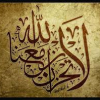
Book Recommendations For New & Existing Muslims
ummtaalib replied to ColonelHardstone's topic in New Muslim?
Gift for Muslims by Muhammad Asad About The book This book is inclusive of a levelled colour-coded Islamic Studies syllabus, linked to the QCA Schemes of Work for schools in the UK. It is designed to be taught in Independent Islamic Schools where teachers can track pupils progress with the attainment targets that the syllabus is based upon, in KS1-3. This simple tracking method can be adopted in any other educational institutes worldwide including Madrasa’s and Maktabs weekend/part-time classes etc. People from all types of backgrounds are able to benefit from the syllabus, including parents, reverts and professionals alike. It consists of the basic essentials that we all should be fully aware of as Muslims. Surahs Dua's Fiqh (Based on Hanafi Fiqh) Aqaa'id Seerah Tajweed Hadeeth Available Here -
Baabul Umrah Minarets - Demolition & Work in Progress 21 September 2013 How it was Old Pictures of Baabul Umrah Area With the Haram Development (Pictures in the next post), this area known to many around the Gate of Umrah has forever disappeared. Many hotels, food outlets, shops, barbers etc. in the narrow, winding streets have been demolished to make way for the development of the Haram.
-

For Friends (Transcribed Discourses Of Shaykh Maseehullah Khan)
ummtaalib replied to ummtaalib's topic in Spirituality
More issues of "For Friends" and many more books HERE -
Then & Now The Prophet’s Masjid, though originally built in the most humble way, was the focal point of establishing all aspects of our Islamic society. It became the magnet for Islam, as well as being a defending fortress. The light of Islam spread from here as Allah Ta’ala had placed His chosen light of lights, Muhammad SallAllahu alaihi wasallam to illuminate the world through his teachings conducted within his Masjid. By the grace and mercy of Allah Ta’ala this light will continue to radiate, regardless of what form or shape the externals of the Masjid may take. And nothing can ever take away the heart’s ecstasy upon contemplating Jibreel Alaihis Sallam descending with new revelations to our Beloved Prophet SallAllahu alaihi wasallam, or the voice of our Beloved Prophet SallAllahu alaihi wasallam repeating these Sanctified Words of Allah Ta’ala, teaching them over and over to his faithful Sahabah RadhiAllahu anhum, and they in turn conveying them to others. The whole of Madinah vibrated with the buzz of recitation. The beauty and sweetness, the nobility of the message, the power and vividness of its imagery, had a masterful sway over the hearts and minds of all. Such was the environment where the final message to mankind was completed and perfected, SubhanAllah! The foremost task to shine from within the mud walls was the spiritual component, congregational Salat, the cohesive core of the Ummah unity, our individual response to the command of Allah Ta’ala, showing our obedience to Him, glorifying His Divinity and seeking His guidance. The establishment of prayer offered the way to purify the heart while strengthening the link between the slave and his Lord. The multi-purpose function of the Masjid was laid down; it became a sanctuary, for the traveler, the distressed, and the needy. It was a place of gathering, not only for local residents, but for foreign tribes and dispatching and receiving various foreign delegates. It was a university, conducting teaching and learning in all aspects of the Qur’an and Islamic sciences. It was a military command centre. The resounding call for Jihad echoed from this meek structure. During times of battle it even served as a hospital. And thus all aspects of a society emanated from Al-Masjid An-Nabawi as-Shairf, Alhumdulillah. Then Sixty four date-palm trunks supported this original Mubarak Masjid, Now there are 2725 marble columns, each 64 cm in diameter. Then A low roof of thatched dried palm leaves was all that was between the worshippers and the searing sun, or the infrequent rains. Now there are 27 moving domes 14.70 meters in diameter and weighing 80 tons each, laminated with a ceramic outside surface, while the inside surface is carved Maple and Moroccan cedar inlaid with gold leaf and turquoise. Electronically controlled to open and shut according to the temperature and climatic conditions. Silently taking one minute to mechanically open and shut, or 30 minutes manually. 12 hydraulically operated umbrellas provide shade in the two internal open courtyards. Ornate ceilings richly carved and decorated and encrusted in all manner of glittering surfaces, giving the illusion of rising heavenward. Then The natural mud floor instilled humility, the forehead cushioned on the hallowed dust of this most sanctified place on earth. Once when it rained the Prophet SallAllahu alaihi wasallam’s Mubarak face, and all others attending the Salat RadhiAllahu anhum, were smeared with mud from prostrating. Many of the Sahabah RadhiAllahu anhum then began bringing in dry rubble and sand to spread over the earth. Upon seeing this Rasulullah SallAllahu alaihi wasallam said: “What a good carpet you have brought in!” Now Polished Italian marble, at times one lifting the hem of your clothing like Bilqees due to it shimmering like the still reflective surface of water and thick plush decorative carpets are now under bare soles. Then The highest house near the Masjid belonged to a woman of the Najjar clan. Just before dawn Bilal RadhiAllahu anhu would come there to sit on the roof waiting for the first faint light in the east. It is said that his call to prayer could be heard all over Madinah at the time. Now a sound system of 206 amplifiers, each 600 watt, with 3500 speakers reverberate the Adhan across the city. Then Three doors were all that were in the original Masjid. Now there are 85 decorative main entrance doors, each 3x6 meters, with countless smaller ones. Then Straw fires lit in the open courtyard for evening prayers at the time of Rasulullah SallAllahu alaihi wasallam. Later oil lamps were attached to the date- palm trunks for the evening and dawn prayers. This was a welcomed innovation from Ash-Sham by Tamim ad-Dari RadhiAllahu anhu, who was more rewarded by the comment by the Prophet SallAllahu alaihi wasallam saying to him: “You have illuminated our Masjid. May Allah Ta’ala illuminate your life.” Now there are 11 electrical sub stations in the basement to power 67,000 brass lighting fixtures, 68 gold plated chandeliers each 6.8 meters in diameter and 110 entrance chandeliers . Then The natural breeze was all that gave respite to the inhabitants at the time. Now a huge air conditioning station located 7 km from the Masjid, connected by tunnels and kilometers of pipes ensures year round pleasant temperatures. The current work plans are to cover the entire outside courtyard with the heat resistant umbrellas. Then After a time a date-palm trunk was set up for Bilal RadhiAllahu anhu to call Adhan from, n Now there are six main soaring minarets at 104 meters, the lower portion granite, the upper section coloured artificial stone, with a crescent made of gold plated bronze, this section weighing 4.5 tons at a height of 7 meters. There are four older minarets from previous expansions. Other features include; CCTV monitoring and control system with 543 cameras! A Fire detection system, escalators, chilling facilities for Zamzam, two levels of underground car parking accommodating 4500 cars, with the new extensions adding hundreds more. The current praying capacity, including the external courtyard, [but not the streets which are overflowing during the peak seasons], and roof area is approximately 800,000. Let us for a moment imagine we are back in time listening to the very words of the first Khutbah delivered by our Noble Nabi SallAllahu alaihi wasallam in his magnificent Masjid. After praising Allah Ta’ala he said: “To proceed: O people, send forth [good deeds] for yourselves. You know, by Allah, that each one of you will be struck [by death]. Then he [that is each one of you] will leave behind his sheep, which will be left without a shepherd. Then, without a translator, and without a veil separating [Allah] from him, his Lord will say to him, ‘Did not My Messenger come to you and convey to you [My message]? I gave you wealth and I bestowed favours upon you; then what did you send forth [that is in terms of deeds] for yourselves?’ He will then look to his right and then to his left, and he will not see anything. Then he will look before him and all that he will see is the Hellfire. So whosoever is able to protect his face from the Hellfire even with part of a date [that is by giving it in charity], then let him do so. And whosoever does not find [even part of a date to give in charity], then let him do so with a good word, for the reward of a good deed is multiplied ten times, and up to seven hundred times. And may peace, the mercy of Allah, and His blessings be upon you.” May our hearts forever be moved by all that went before, reliving through all means available to us the essence of our glorious Deen as shown to us by our most cherished of creation SallAllahu alaihi wasallam and his esteemed Sahabah RadhiAllahu anhum in the most blessed of cities, this Forever Radiant Madinah, the Humble. Ameen. Al-Miskeenah
-
Finding the One! By Sister Taaiebah Ebrahim As a pretend statistician, I'll say it's statistically proven that females are more prone to being caught up in idealistic romantic notions of love especially since we tend to be more emotional beings and brainwashed by fairytales of damsel’s in distress and the knight in shining armour hype. Naturally, as a young girl, I had far too many self-edited fairytale re-runs constantly playing in my head. My excitement was always in anticipation of when my prince would romantically woo me, with me being obviously unaware, just as it was in those fables. Truth be told, I was always aware that those fables were indeed far from reality, so nothing surprised me and every person seemed fairly predictable. But even so, I hoped for a miracle - someone original to sweep me off my feet. And then I was approached…I was given the longest love letter, ever. I was flattered that Someone had taken the time to write to me and was most definitely intrigued. But - I didn't really know Him. So I thought, at least let me, hear Him out, after all, there was a great amount of effort put into this letter. In all honesty, it was quite entertaining. The letter reflected warmth, beauty, bravery, it was so inspiring. It was like a dream sometimes where good battled and won over evil. There were heroes overcoming their weaknesses, there were love stories (my favourite) and other stuff, but really, the whole thing was about me. I knew this because my name was written all over the place. I was totally in tuned with the Author and was taken aback at how He knew so much about me. Everyday I got presents from Him too. Now, I'm not the type to get bought over, but these gifts were too nice to return to sender, if you know what I mean. So, I'd read portions of His letter everyday...and to be honest, gifts aside, He really started growing on me and the more I'd read His letter, the more attached I became to Him. Even though I didn't meet Him yet, I really started to like Him. The more I read, the more love I felt . He seemed to tick all the right boxes; He was knowledgeable, spoke about every topic relevant from animals to society and its challenges. He always made me feel so special by making reference to me, all the time. He would go on and on about how He would do anything for me… I just had to ask. So that was nice. He got me thinking. I mean this was it. It's the moment we wait for our whole lives. The magic moment that reroutes your future in a simple decision. But as my eyes got bigger, I'd keep reading things in this letter, that I wasn't sure I was ready to hear. There was a commitment, yes indeed a BIG one! I was at a crossroad. Take Him or wait for someone else. The decision, however, was clear and there was no real choice to be made. It was more like a one way street than a crossroad. He promised to listen to me, when everyone failed to understand me. He'd appreciate my humour, understand my emotions and my demeanour. He promised to never break His promises. Could I really believe Him? He said this whole world and everything in it was nothing compared to me. His words kept on taking my breath away. He seemed so perfect and I felt so honoured and fortunate. I realised I found the One! As the letter began to conclude, He then beautifully and eloquently said… "Qul huwa laahu Ahad" (Say: He is Allah, the One.) (Quraan 112:1) This love letter was the Qur’aan, obviously, and the perfect One indeed is. ..ALLAH, THE GREAT. You see, before I wrongly assumed this craving for love and understanding needed feeding from a human. And while being fully aware of humans and their flaws and predictabilities, I never saw the One who was always there. I realised it was Allah that was always will be my first and true love. The point is that we all have this insatiable gap that needs feeding and we're always craving to feel complete. It's an unsettling feeling knowing something's missing. And until we begin to realise that it can only be filled with accepting Allah's love, we'll forever be searching for temporary fixes that promise no certainty. Without any judgement, it's understandable in our modern life age to blindly hunt for short-lived reliefs to numb the nagging aching in our chests – after all, we've been coached since young to seek out quick fixes. But it's no reason to your life's betterment to insist on this sort of addictive cycle. We don't have to wait until we all eventually reach the moment of 'Heeeelp! My cup runneth over!'. It'd be a good idea to nicely sit your sub-conscious down for a no-nonsense one-on-one family meeting, and make it realise that so long as it goes on autopilot in search of completion in anything or anyone outside of yourself, it and you will always feel unfulfilled and super sucky. Being consistently strong in a new way of thinking, trains your sub-conscious to new automatic patterns. Look for permanent freedom - not temporary relief peeps. Another point to note is to avoid placing the unrealistic expectation of finding perfection in a partner. Everything we've been conditioned to look for in a spouse, is in Allah in perfection, so rely on Him alone to see to your needs, and share your joys with your spouse. Allah is indeed the Only True Love, He is First and Last, His Love is a beginning without an end, His promises are all true, all we need to do is Love Him and love for His Sake and when every other Love dims the Love of Allah will still shine bright! www.eislam.co.za


